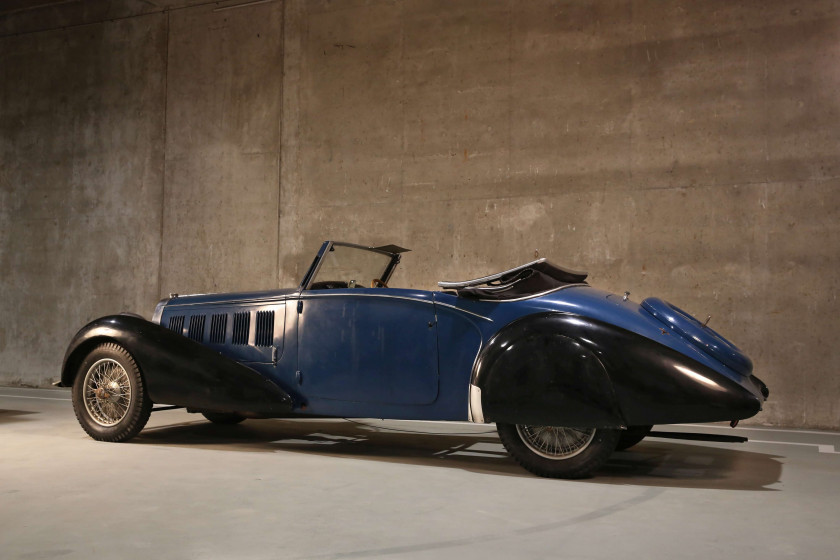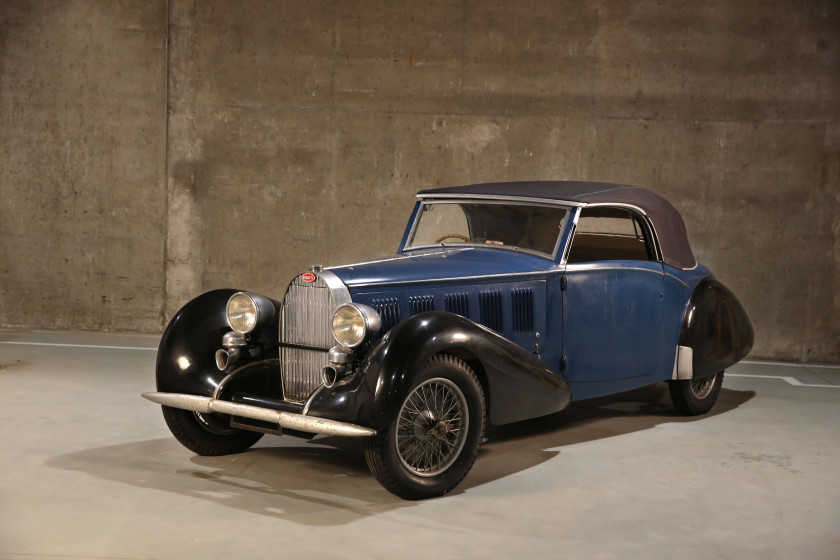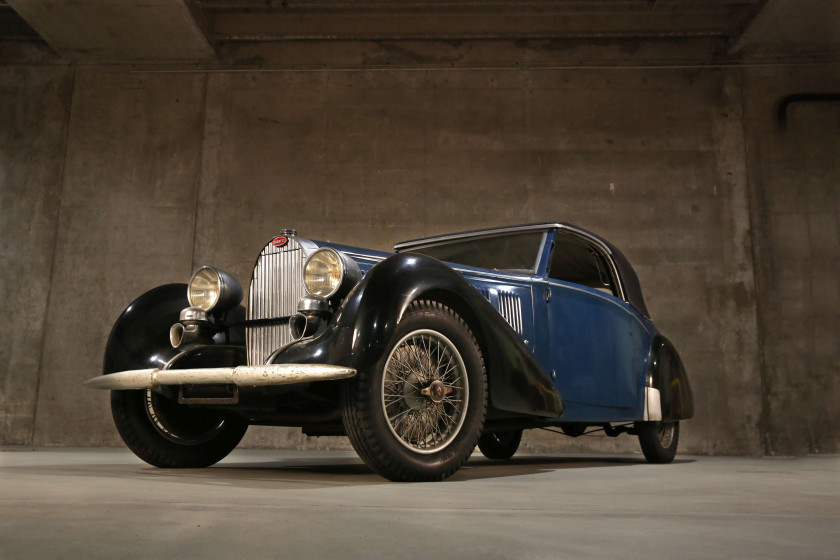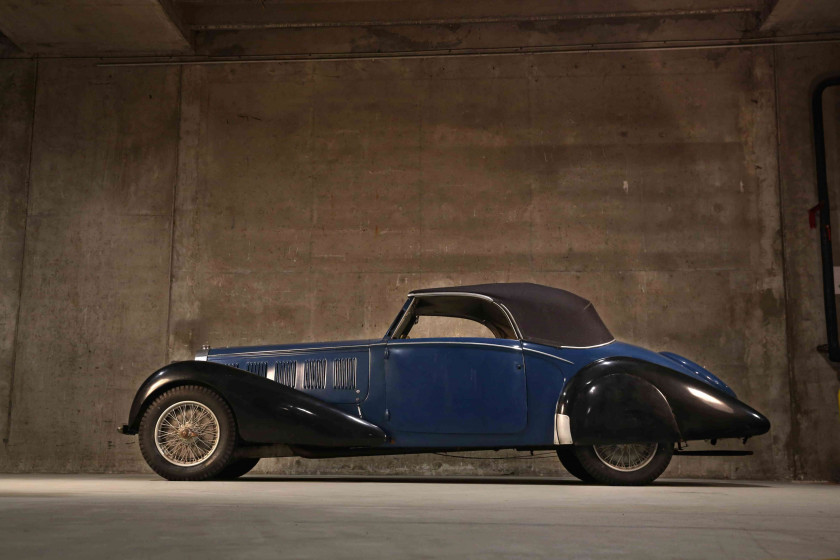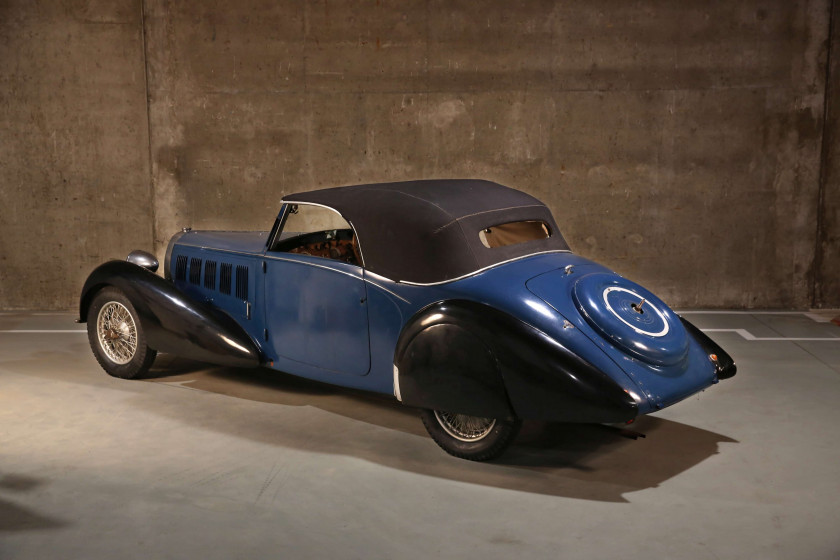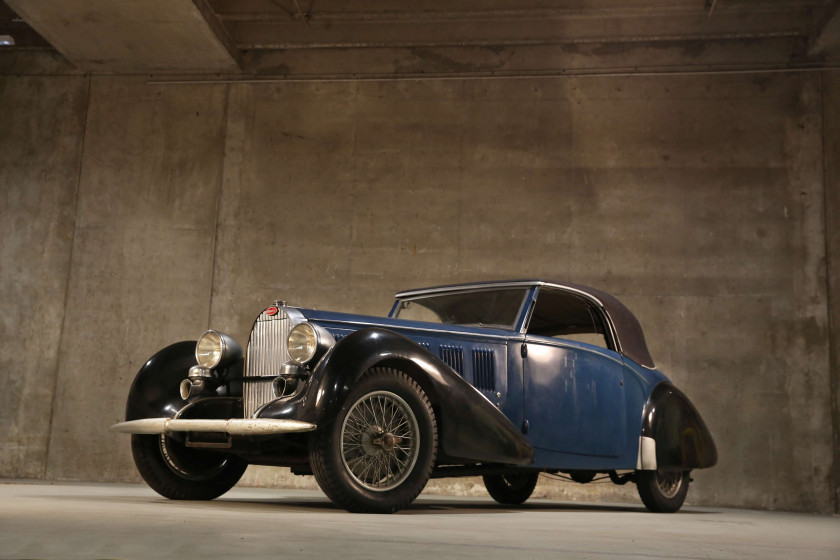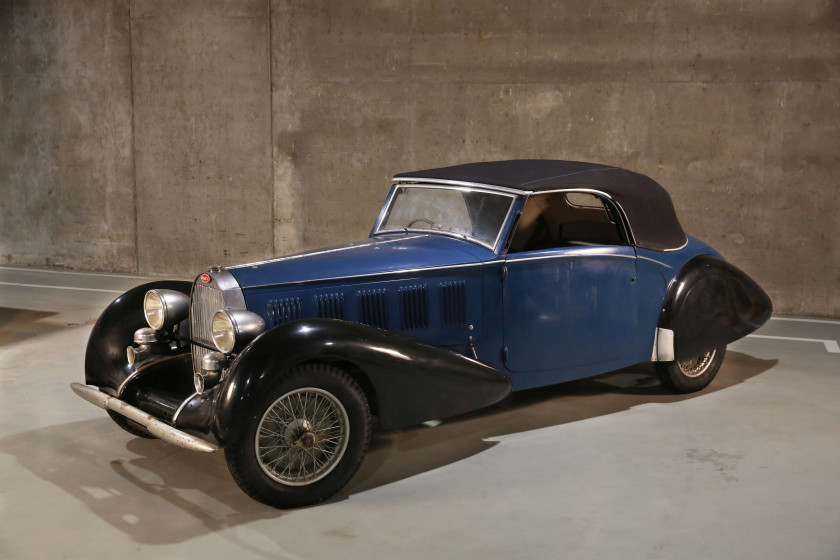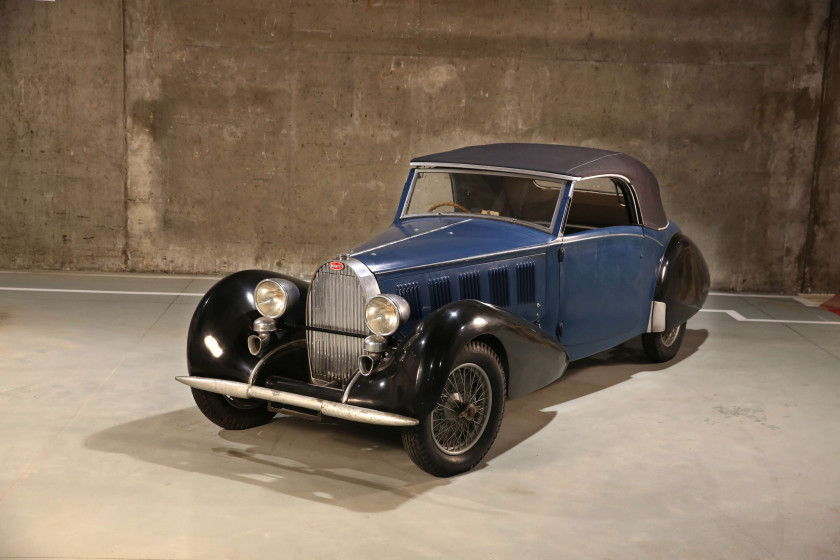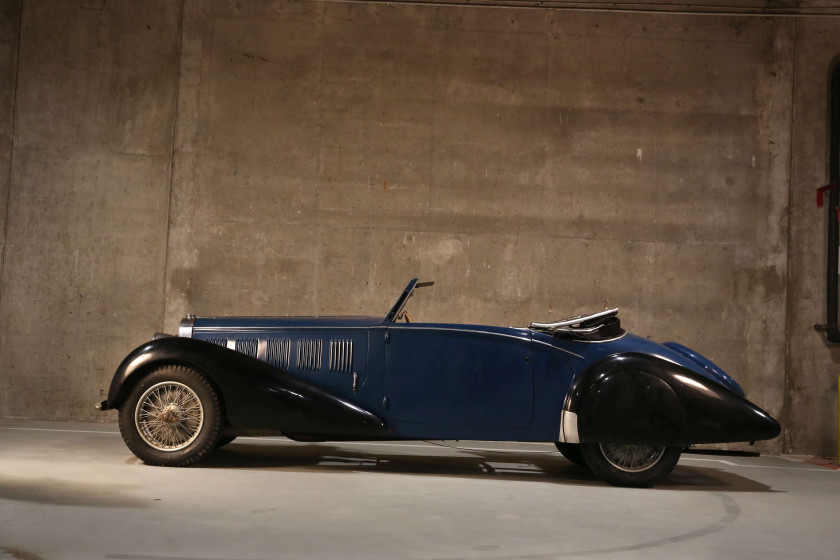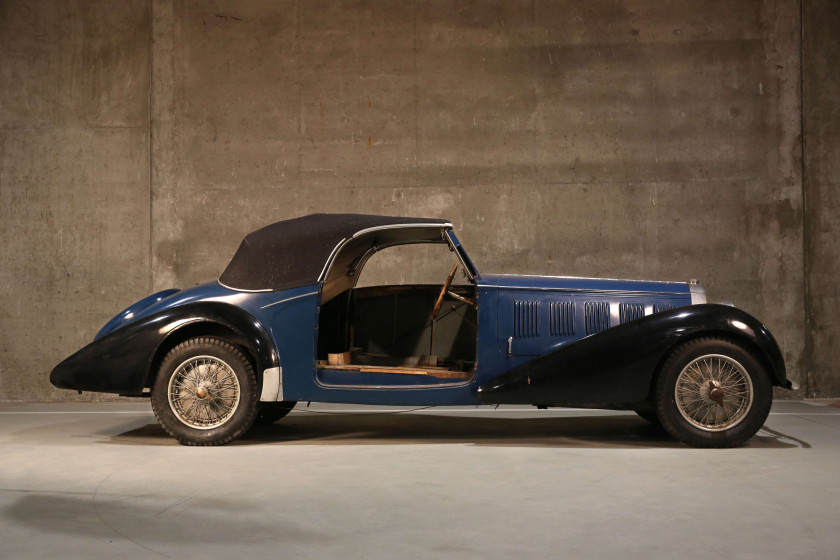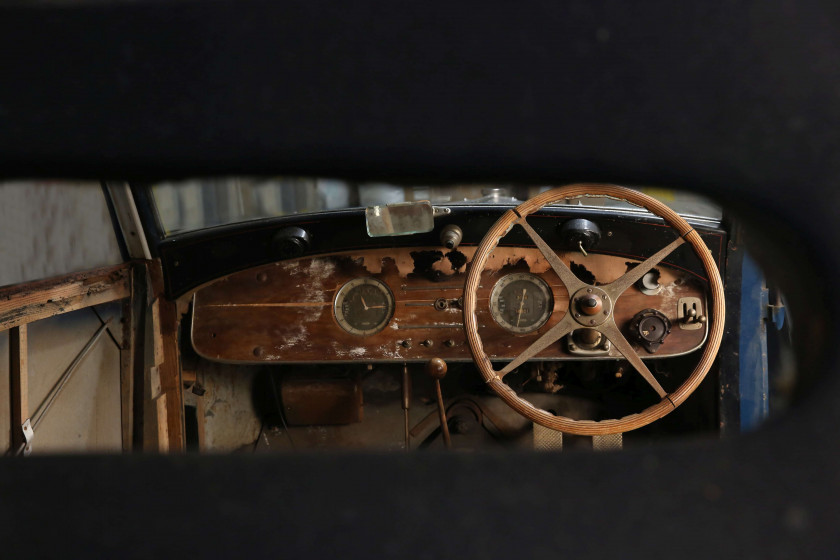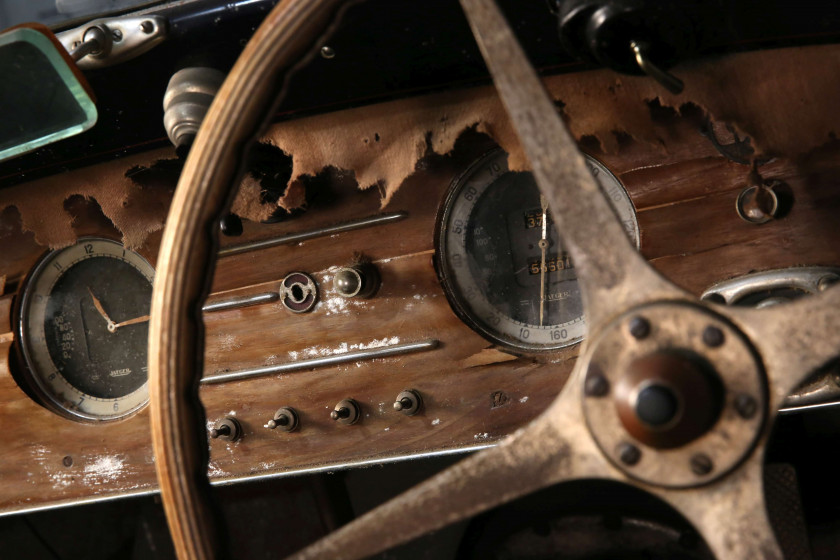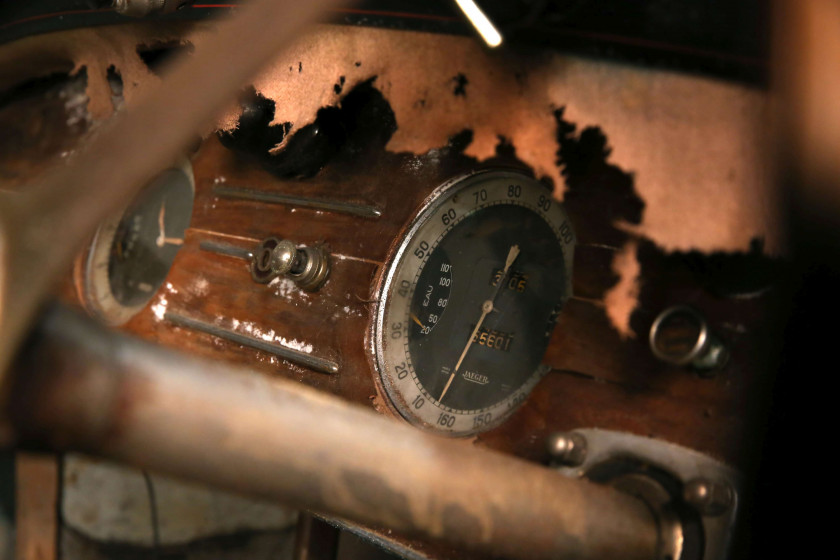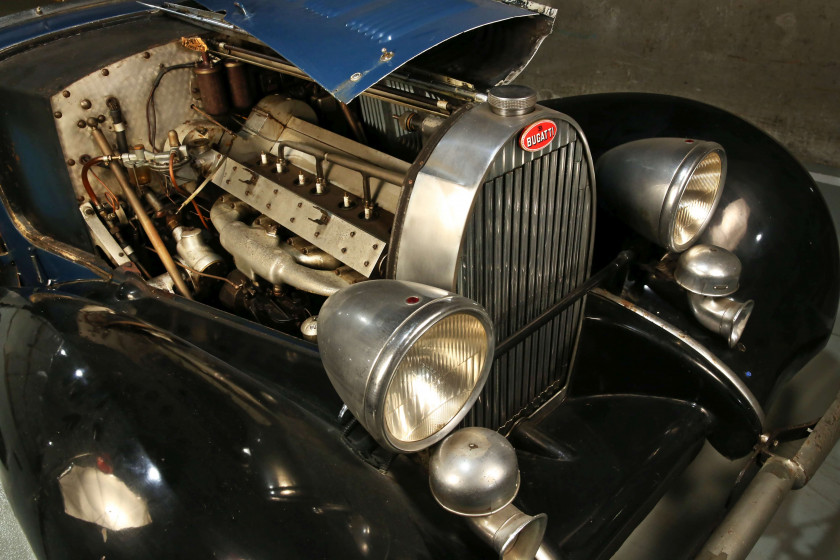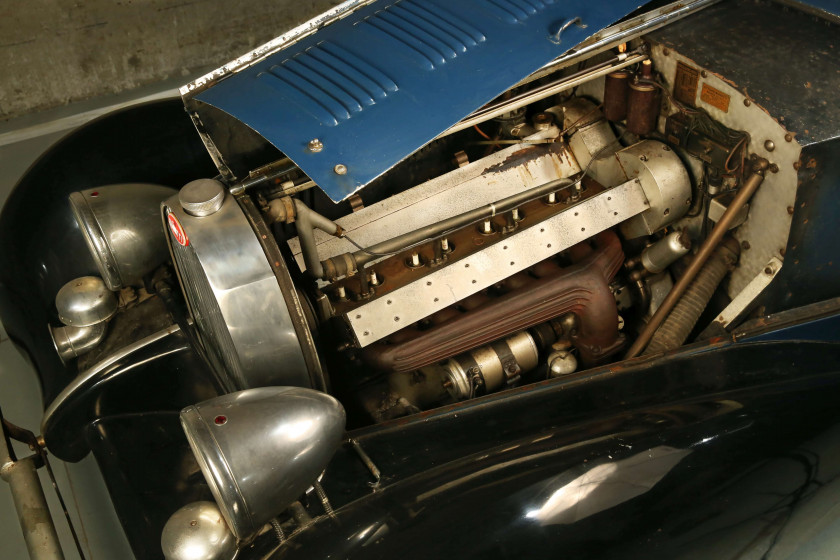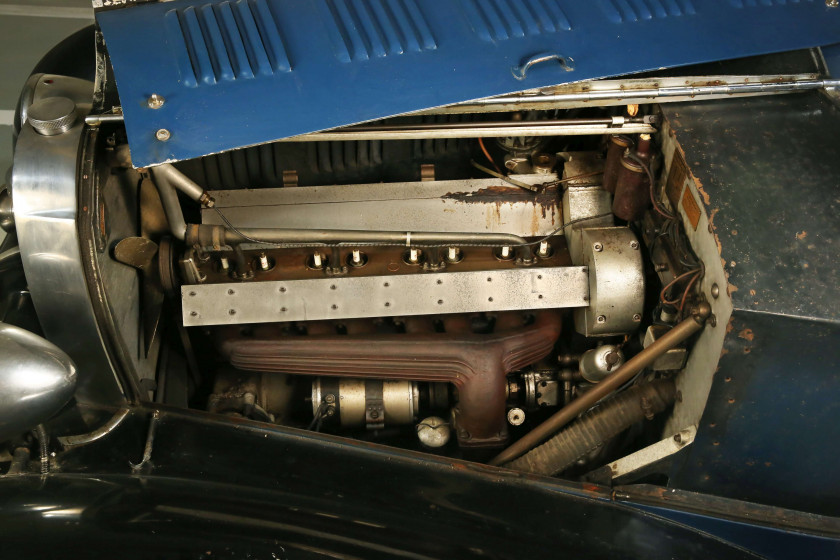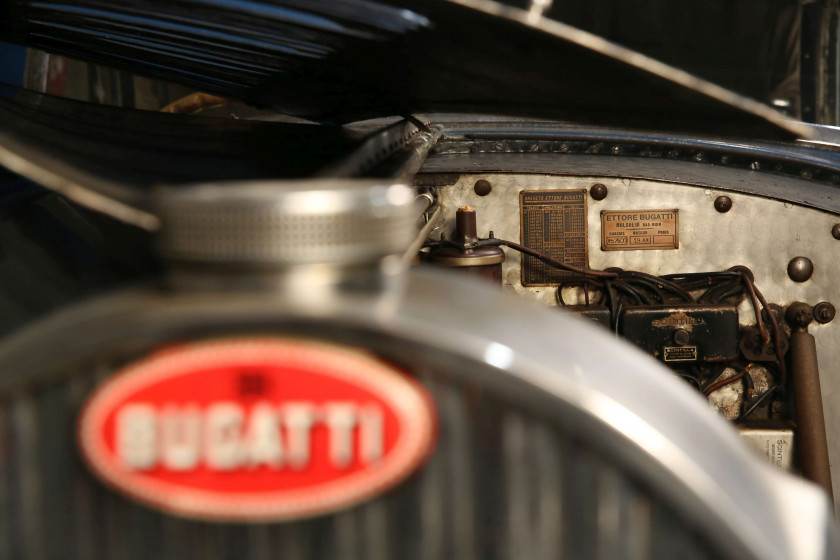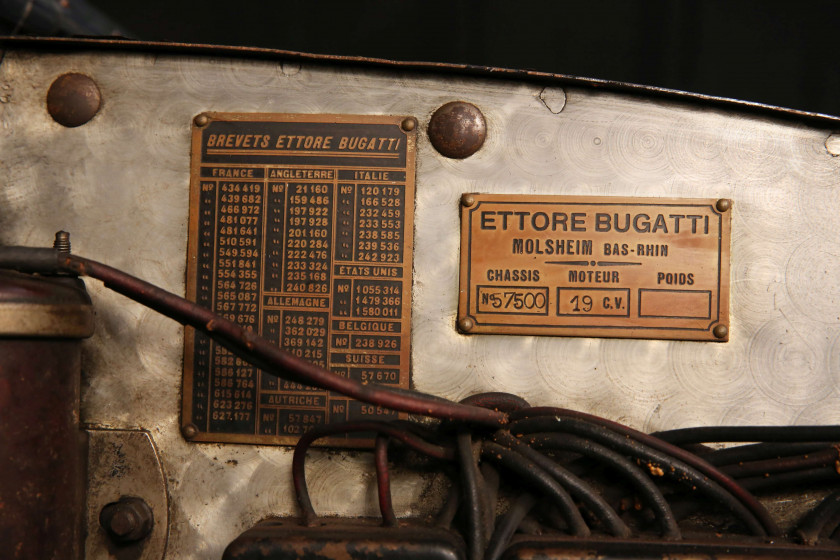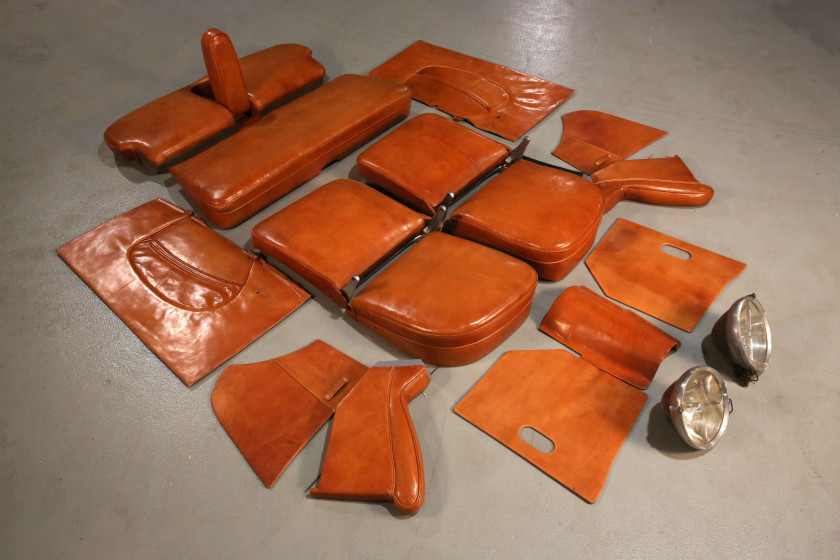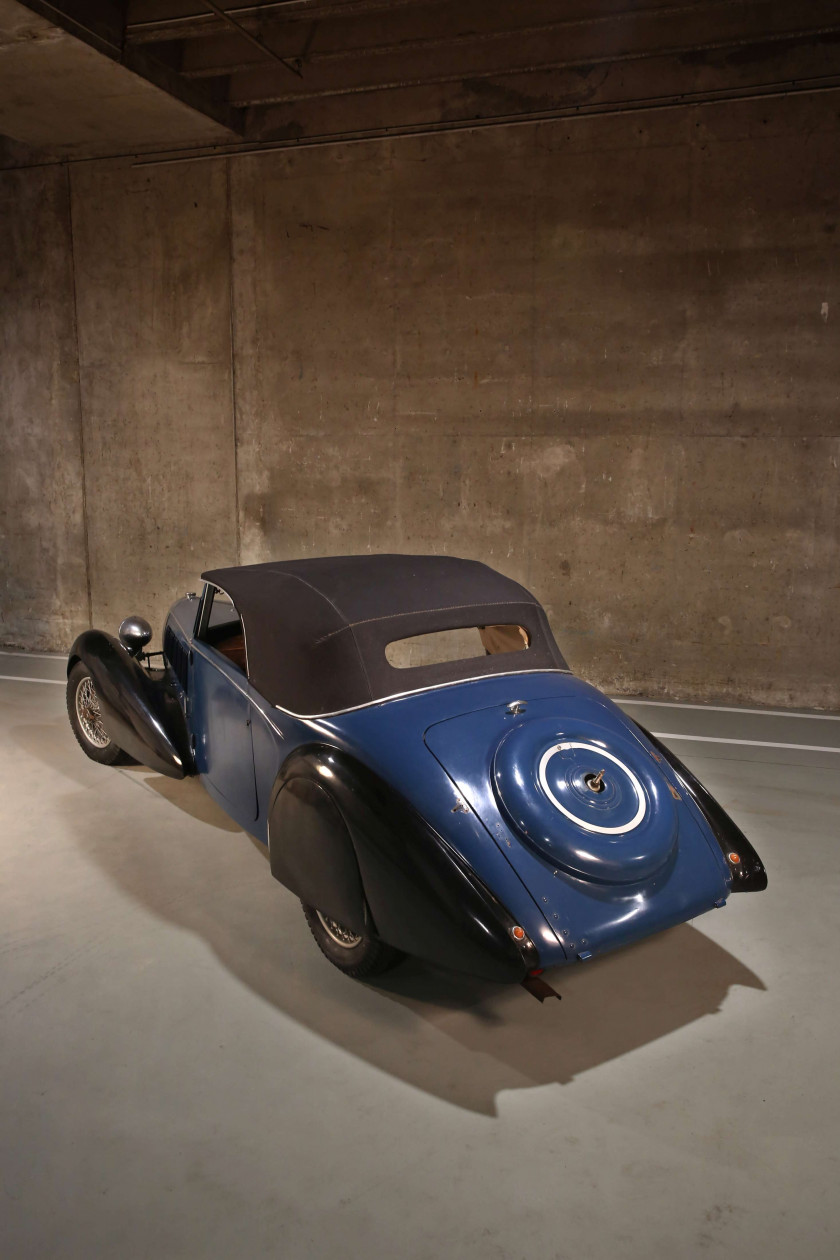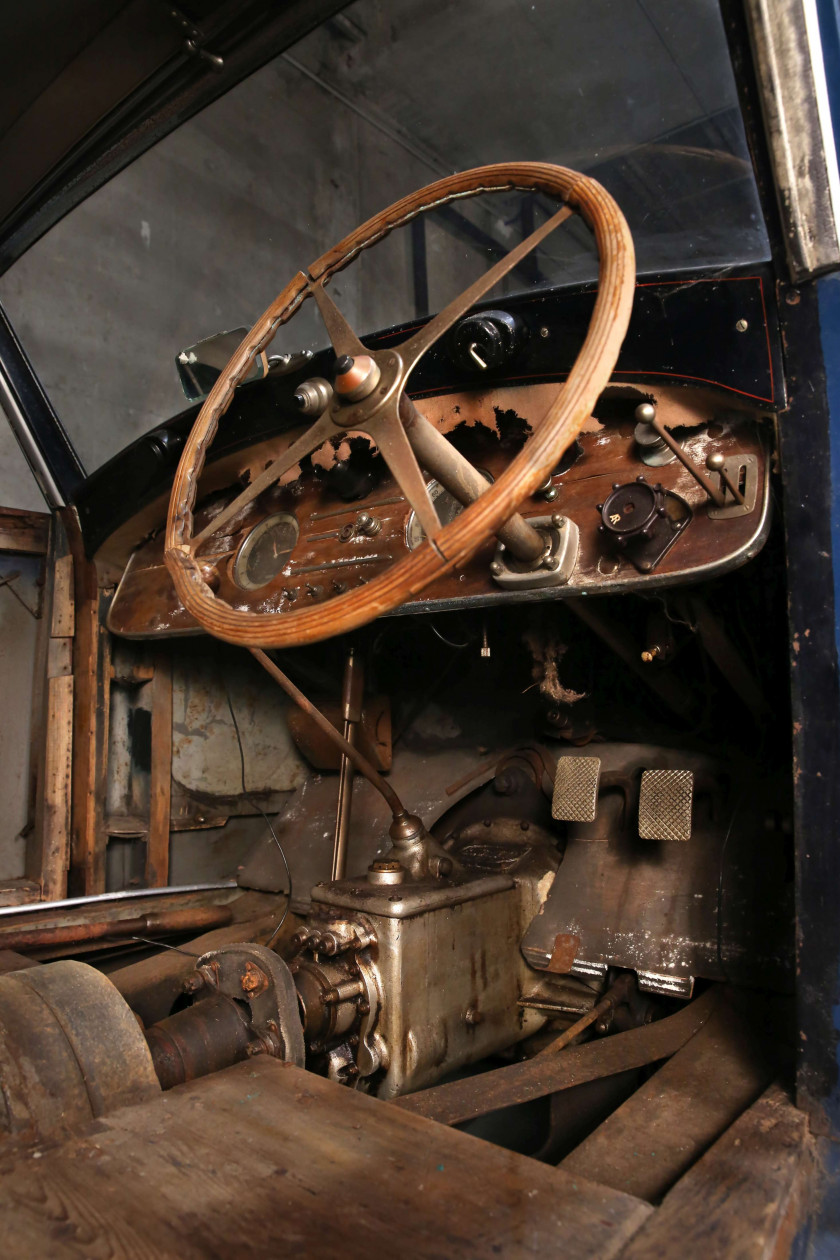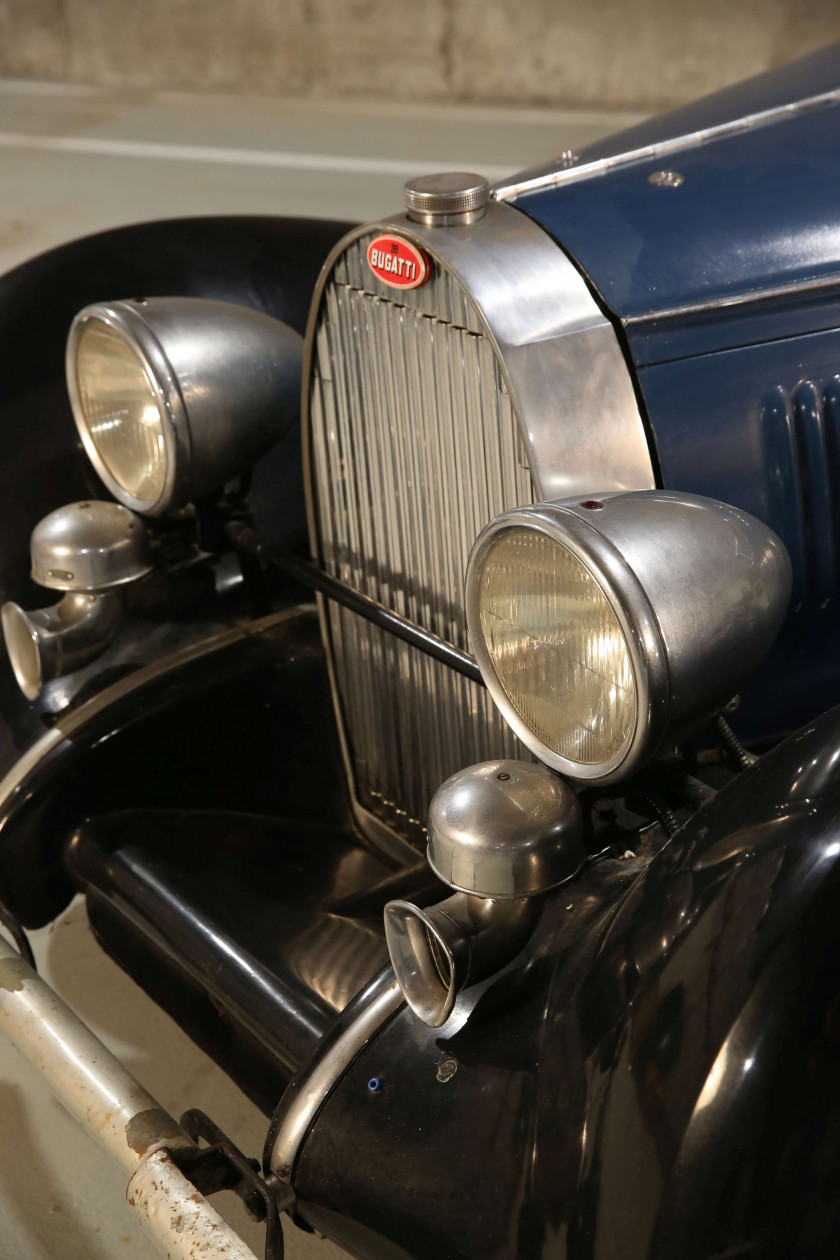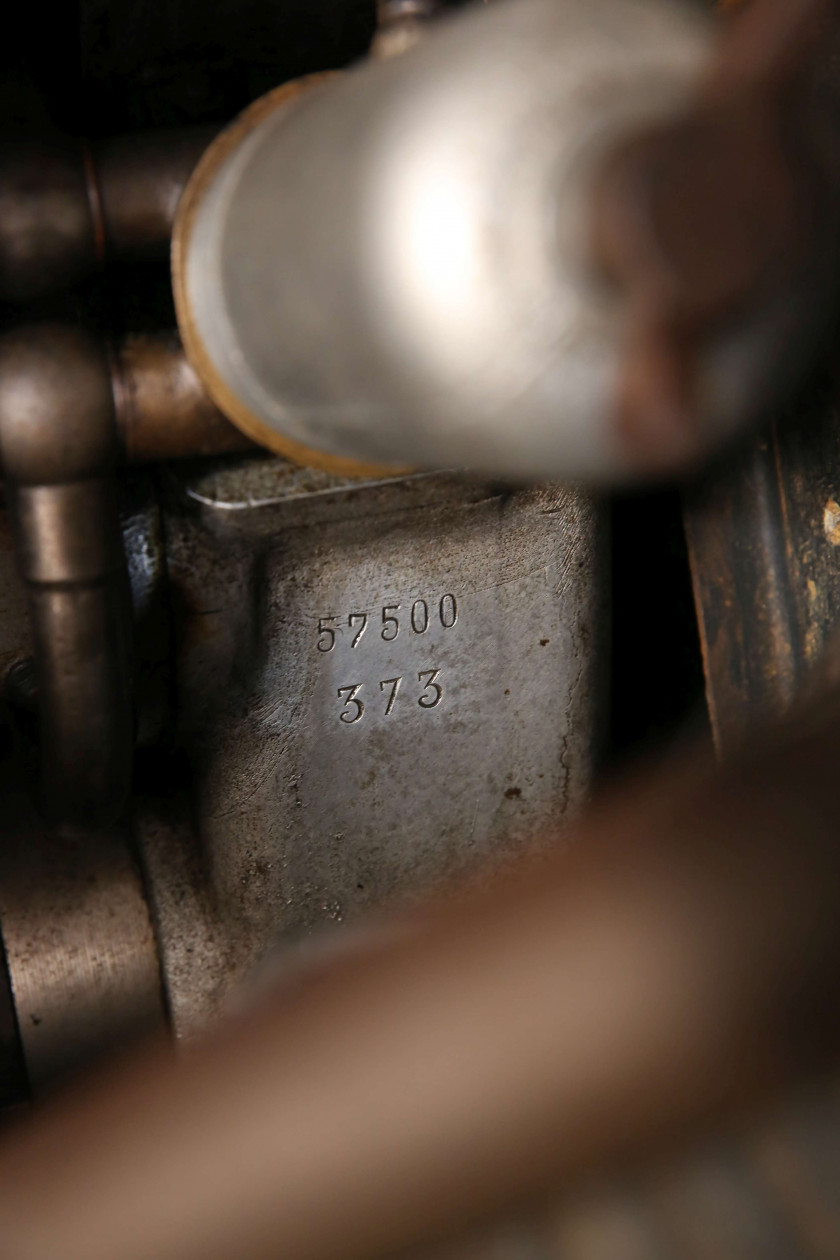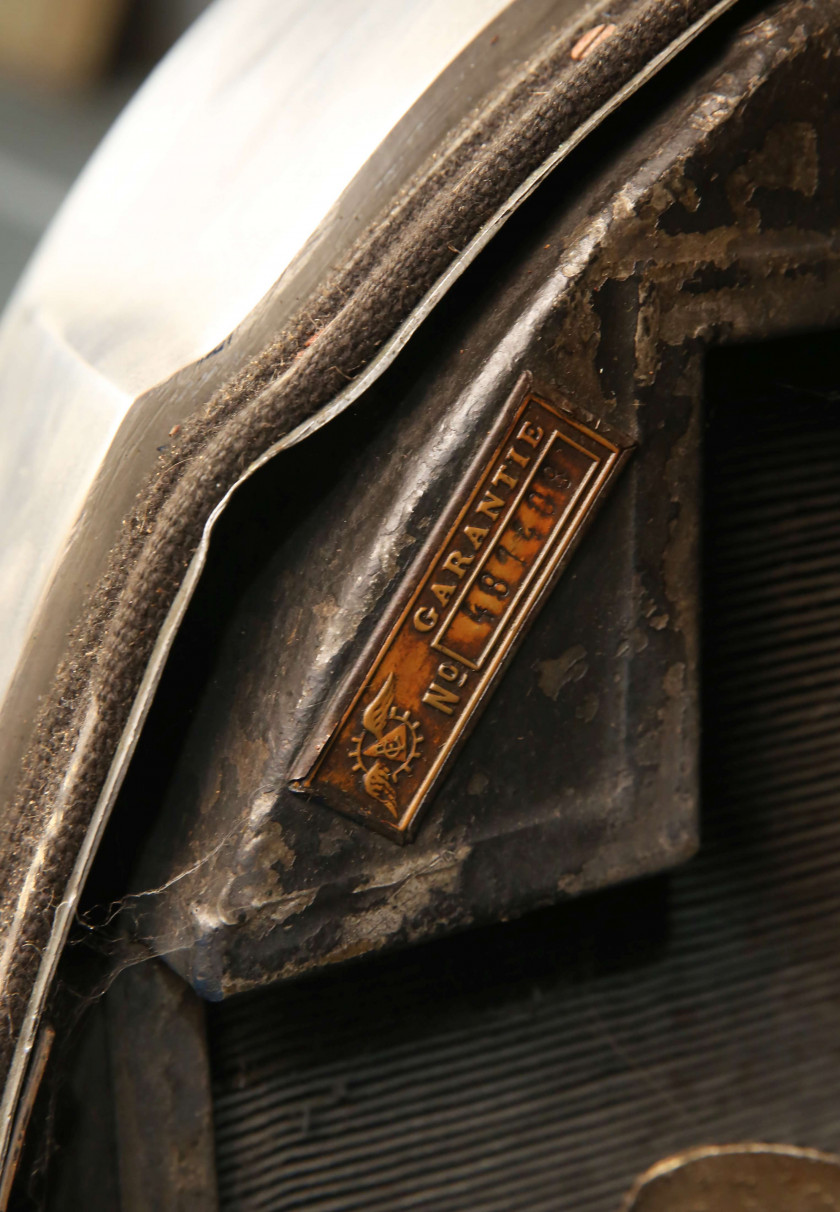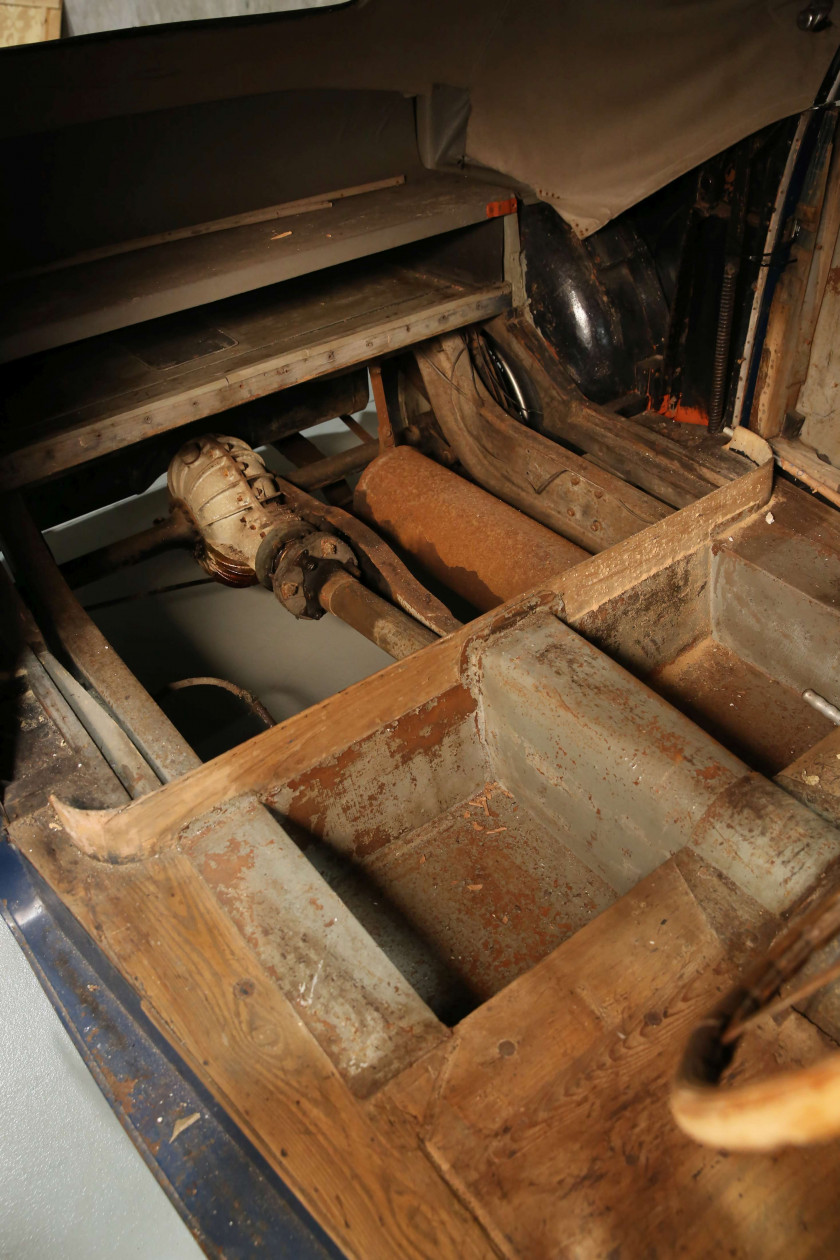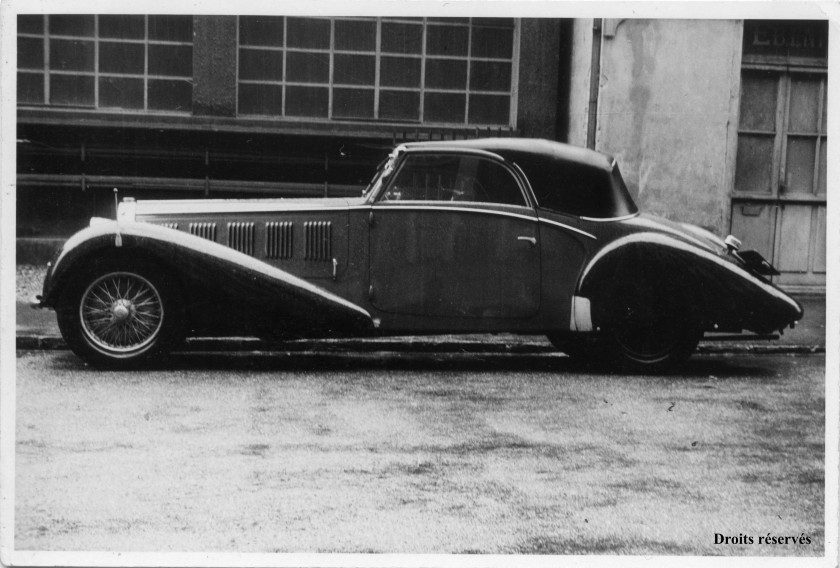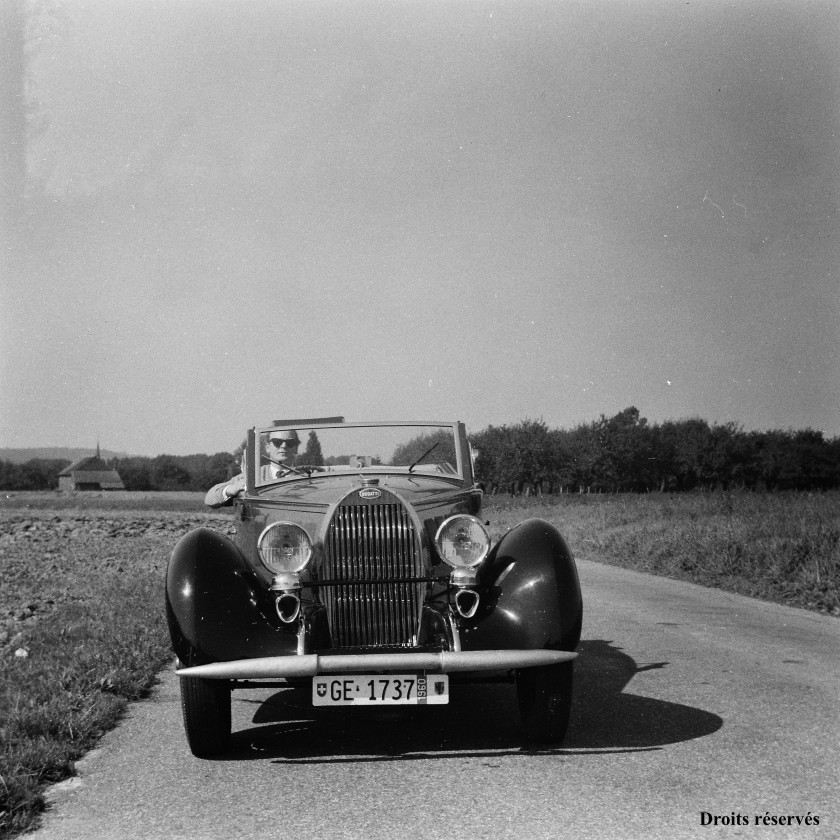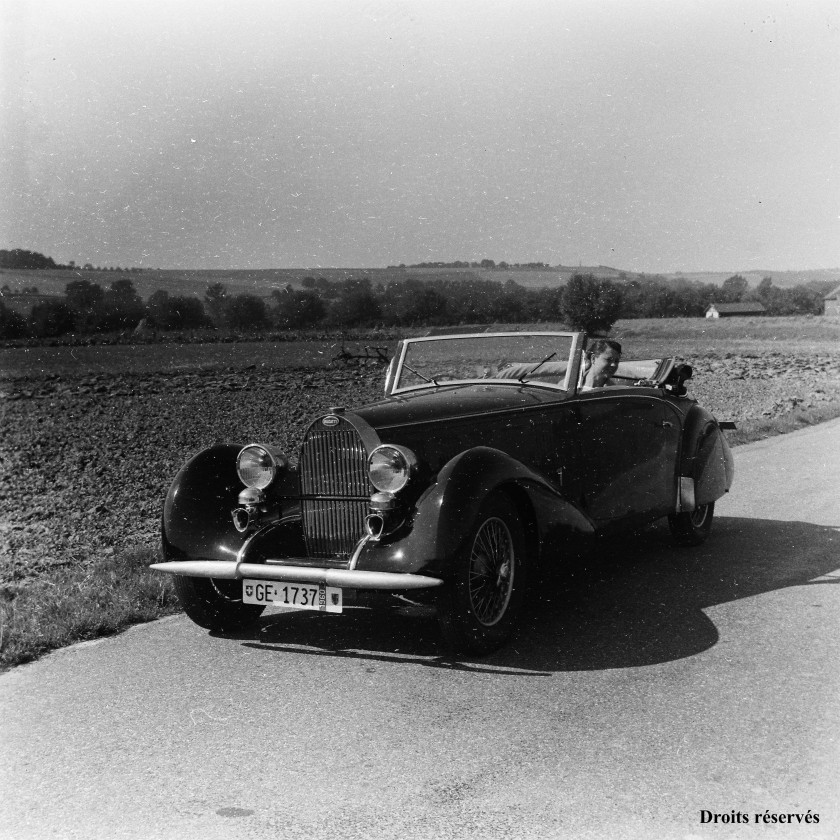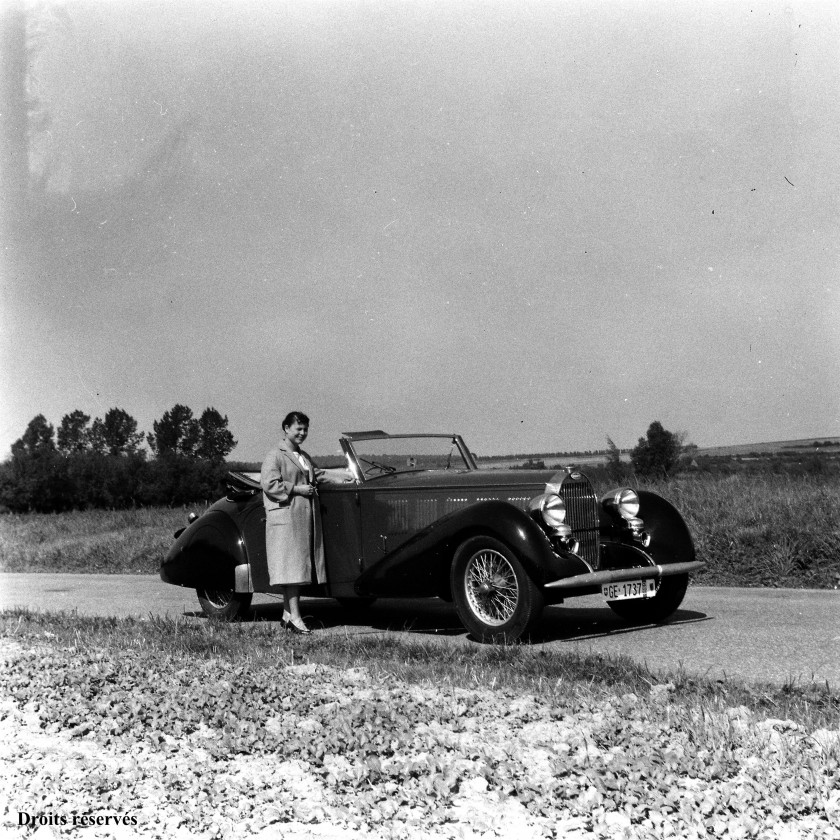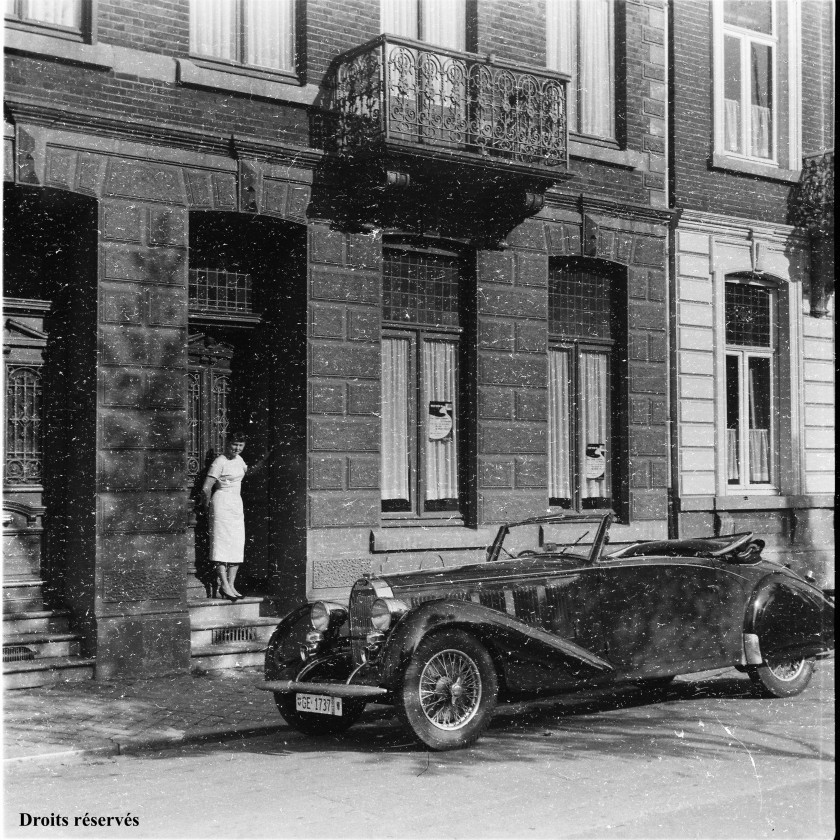Sale Rétromobile 2019 The Official Sale - 08 february 2019 /Lot 30 1937 Bugatti Type 57 Cabriolet par Graber No reserve
1937 Bugatti Type 57 Cabriolet par Graber
No reserve
Titre de circulation hollandais
Châssis n° 57500
Moteur n° 373
Boite n° 373
Pont n° 373
- L'une des plus belles réalisations de Graber
- Historique limpide avec seulement 3 propriétaires
- Dans les mains d'August Thomassen depuis 1960
- Moteur, boîte de vitesses et pont d'origine
- Fantastique projet
- Sans réserve
La naissance de cette Bugatti Type 57 commence en janvier 1937, au moment de l'assemblage du châssis 57500 et du moteur 373, en même temps que sept autres châssis du même modèle. Le 9 février 1937, le châssis 57500 fait l'objet d'une commande de l'agent Bugatti de Genève, Jean Sechaud, la date de livraison prévue dans le programme de fabrication étant le 12 février. Pour une fois, l'usine tient ses délais car le châssis est effectivement livré le 15 février 1937.
Depuis Molsheim il est ensuite acheminé, sans doute par la route, chez le carrossier Herman Graber, à Wichtrach, en Suisse. De 1926 à 1940, ce carrossier de bonne réputation a réalisé 751 carrosseries pour les marques les plus prestigieuses, comme Bentley, Bugatti, Delage, Delahaye, Duesenberg, Lagonda, Lancia, Maybach, Mercedes, Packard et Voisin.
Les registres de H. Graber indiquent les numéros des contrats (qui sont peut-être ceux des caisses) à partir du numéro 300, en septembre 1934. Ainsi, la voiture n°300 est une Bugatti cabriolet 4 places, châssis 57161, et la première de neuf Bugatti 57 cabriolets réalisées par Graber entre 1934 et 1937. Il s'agit en 1936 des châssis 57394-57444-57448-57483 et, en 1937, des châssis 57446-57447-57500 et 57539. Pour ces cabriolets, les numéros de références des caisses Graber sont compris entre 300 pour le châssis 57161 et 372 pour le dernier châssis 57539.
Tous ces cabriolets Type 57 Graber ont survécu. Leur carrosserie diffère notamment par certains détails. Ainsi, celles des châssis 57444-57448-57483-57446, dans l'ordre de fabrication, comportent toutes un capot à trois rangées de trois ouïes verticales. La carrosserie du châssis 57447 présente cinq rangées de cinq ouïes inclinées et celle de 57500 est la seule à posséder cinq rangées d'ouïes verticales. De plus, les caisses de 57171-57394 et 57539 sont uniques dans leur dessin et leur style.
Le registre original du carrossier Graber indique pour 57500 : " Ch 15.2.37. Bugatti N° 363. Ch 57500.Mot 373. J. Sechaud. M. Barbey ". Les archives du carrossier renferment trois négatifs 24x36 mm qui montrent le cabriolet 4 places 57500 dans la campagne bernoise, le jour de sa livraison par Graber. Avec une robe unicolore, sans doute bleu nuit ou noir, la voiture est équipée de flasques de roues, accessoires classiques de cette période. Les phares, les deux avertisseurs et les pare-chocs très particuliers, montés par Graber à l'origine, se trouvent encore aujourd'hui sur la voiture.
Comme l'indique le registre Graber mentionné plus haut, le premier acheteur de cet élégant cabriolet 57 est Raymond Barbey, petit-fils du banquier Gustave Ador et lui-même administrateur délégué de la Banque Lombard-Odier de 1941 à 1973.
Les archives d'un collectionneur, qui notait quantité d'informations sur les belles voitures circulant à Genève dans les années 1940, fournissent quelques renseignements sur la voiture : " Bugatti immatriculée GE 18787.Encore en circulation en 1940. M. R. Barbey, fondé de pouvoir à Chambesy. " Nous avons la conviction que M. Barbey conserve sa Bugatti pendant la guerre et ne la revend qu'au lendemain du conflit. Il est noté en 1962 dans le Bugatti Register de H.G. Conway que Le banquier n'utilisait sa Bugatti que l'été et qu'elle aurait passé la période 1939-1947 dans le magasin d'exposition du garage Sechaud, mais la fiche de 1940 semble infirmer partiellement cette information, puisque la voiture était encore dans la circulation à ce moment-là.
Quoi qu'il en soit, le cabriolet est pris en dépôt par Jean Sechaud pour révision, avant revente à un client et amateur de Bugatti, Georges Pertuiset. A ce propos, les archives de la police suisse indiquent : " Bugatti type 57 châssis 57500, plaque GE 31319 le 24 mai 1951. Georges Pertuiset, né en 1883, Industriel, 3 rue du Marché à Genève. " M. Pertuiset dirige alors " G. Pertuiset, Biscuits Chocolats et Pains d'Epice ", entreprise familiale ancienne et florissante, dont les confiseries sont envoyées dans tout le pays.
Il existe une photo partielle du cabriolet Graber avec son immatriculation GE 31319, dans le garage de Jean Sechaud rue du Stand, à coté d'une Ferrari 195 Inter de 1950 ou 1951, sans doute avant le Salon de l'Automobile de Genève. Si nous sommes au printemps 1951, l'auto vient peut-être d'être achetée par Pertuiset.
En 1954, selon les notes de H.G. Conway, la Bugatti est révisée par Sechaud et, après presque dix ans d'utilisation par le biscuitier genevois, elle est cédée le 3 décembre 1960 pour 650 CHF à August Thomassen, domicilié Hôtel des Rives du Rhône à Vernier, un quartier de Genève. Sorti de révision peu de temps avant son acquisition, le véhicule est alors enregistré sous la plaque GE 1737.
Né à Maastricht le 25 août 1923, August Thomassen conjugue sa passion de la sculpture avec celle des Bugatti lorsqu'il produit un très beau buste en bronze d'Ettore Bugatti encore exposé au musée Schlumpf de Mulhouse. Il ne semble pas avoir beaucoup roulé avec sa Bugatti 57 mais a néanmoins commandé une sellerie neuve qui ne fut sans doute pas montée. La peinture deux tons, bleu et ailes noire, date certainement de la période où la voiture a été révisée pour G. Pertuiset. La Bugatti sera ensuite immatriculée en Hollande sous le numéro BX 65-64 au nom de A. Thomassen, à Maastricht.
L'examen du véhicule laisse apparaître une voiture possédant l'intégralité de ses composants mécaniques d'origine. L'essieu avant est gravé 373. La plaque châssis originale indique 57500-19CV. La patte arrière gauche du moteur reprend les numéros du châssis et du moteur, soit 57500-373. Le couvercle et le corps de la boîte de vitesse sont marqués 373. Le pont arrière est gravé au rapport 11X46 et porte le numéro 373. Le tableau de bord possède sa planche d'origine qui présente deux grands instruments : une montre Jaeger et un compteur de vitesse gradué jusqu'à 160 km/h. Le châssis est équipé de freins à câbles.
La carrosserie cabriolet Graber 4 places qui habille le châssis 57500 est unique. C'est certainement l'une des deux plus élégantes réalisées en 1937 par ce carrossier, sur un châssis Bugatti Type 57.
Pierre-Yves Laugier
August Thomassen naît en 1923 dans une famille de cinq enfants à Maastricht. Il est le fils d'un pharmacien et d'une mère d'origine française qui vit pour la peinture, la littérature, la musique, la culture.
Le père Thomassen est un des premiers à circuler en automobile à Maastricht et sa fille aînée est même la première femme de Maastricht à avoir un permis de conduire ! Le samedi, le petit August a le droit d'accompagner son père dans la voiture pour la livraison des médicaments dans les villages environnants. Les vacances se font également en voiture et elle mène la famille en France. Tellement fasciné par ce phénomène automobile, à 8 ans, August fabrique sa première voiture en bois. Cette passion ne va plus le quitter.
August est un enfant original qui s'échappe toujours pour partir à l'aventure. A 9 ans, il tombe d'un pont et entre dans le coma pendant trois semaines. Après avoir survécu aussi à la paralysie infantile et à la polio, il devient l'enfant terrible de la famille à l'adolescence. Là où son frère et ses sœurs suivent leurs études universitaires, August aime être au contact des artisans, des techniciens et des mécaniciens. Bien qu'interdite par sa famille, sa fascination pour le mouvement et la vitesse l'emmène au vélo de course, discipline dans laquelle il remporte de nombreuses victoires. Ses sœurs cachaient ses trophées dans leurs chambres à coucher. Ses parents lui permettent de quitter le lycée à l'âge de 15 ans et le laisser rejoindre la fameuse école Autoschool à Den Bosch. C'est alors qu'il commence également la sculpture.
La guerre éclate. Son frère aîné est un chef de la résistance. Un soir, alors qu'il aide les gens à faire passer la frontière, il est repéré par les allemands. Après un interrogatoire douloureux, il est déporté en camp de travail en Allemagne où des bombes sont fabriquées par les prisonniers. Afin de ne pas collaborer, il se coupe délibérément un doigt. Un soir, il décide de s'enfuir dans une évasion spectaculaire où il s'accroche sous le châssis du train de marchandises qui traverse le camp. En habits de prison, le jeune August parcourt l'Allemagne hitlérienne en sautant dans les trains. Au risque de la fusillade, il atteint finalement les Pays-Bas en vie, grâce à un conducteur de train allemand silencieux et bienveillant. Après une nuit passée dans un cercueil au cimetière, il se rend chez ses oncles Brand (de la bière Brand) qui le laissent partir se cacher dans leur villa à Eijsden. Durant cette période cachée, il développa sa seconde passion: la sculpture. La résistance le mène à intervenir dans la RAF en Angleterre jusqu'à la fin de la guerre.
Après la guerre, il fabrique une moto à partir de pièces détachées et voyage en Espagne pendant 5 mois. Il étudie pendant trois mois à l'Académie des Beaux-Arts de Madrid et au Prado où il sent le destin de sa vie s'imposer : la recherche de la beauté humaine à travers la sculpture. À son retour, il est admis à l'Académie Royale des Beaux-Arts de Bruxelles, où il obtient son diplôme avec un premier prix en portrait. Sa première commande est de deux sculptures de trois mètres de haut pour les usines de biscuits ´Liga'. Avec cette première vente, il achète un terrain en Belgique et construit le studio où resteront ses futures Bugatti T49 et T57, ainsi que la Citroën Trèfle, pendant près de 60 ans.
Les commandes de ses portraits psychologiques d'hommes politiques, d'acteurs et d'industriels le conduisent à Genève, où il achète sa deuxième Bugatti T57 du chocolatier genevois Pertuiset. Sa première Bugatti T49 a alors déjà été achetée dans les Vosges, à Germigny, chez deux paysans qui s'en servaient pour transporter les pommes de terre ! En 1958, il épouse la belle Renée Van Noorden, qui l'assiste désormais dans ses passions. Ensemble, ils auront deux filles. Il joue du violon, ce qui lui permet de contrôler son caractère hypersensible et agité.
En 1963, il achète un site dans les montagnes de la Haute Savoie: la terre de ses ancêtres. Il y construit son deuxième studio, et se sentira français toute sa vie. Là, il travaillera également pendant des années pour remettre dans l'état d'origine son adorée Bugatti T40, ceci aux côtés de Schneider, l'ancien maître-artisan de Gangloff. Vers 1985, son buste d'Ettore Bugatti est acheté par le Musée National de l'Automobile à Mulhouse, où il y est encore aujourd'hui. En 1987, son buste en bronze de Yehudi Menuhin est dévoilé par le fameux violoniste dans son école éponyme à Londres. Le buste de Lips, fondateur du Musée National de l'Automobile de Hollande est inauguré en 1990.
August Thomassen travaille sur ses deux passions, les Bugatti et la sculpture, dans ses ateliers en Belgique et en Haute-Savoie jusqu'à sa maladie à l'âge de 90 ans. Personne n'est resté insensible à cette personnalité passionnée et charismatique qui a façonné sa vie de manière aussi décalée et en dehors de tous les sentiers battus.
Comme l'a écrit Yehudi Menuhin :
"Je vous admire - le grand sculpteur qui ressent profondément".
Dutch title
Chassis n° 57500
Engine n° 373
Gearbox n° 373
Axle n° 373
- One of Graber's most beautiful creations
- Transparent history with just three owners
- Owned by August Thomassen since 1960
- Original engine, gearbox and axle
- Fantastic project
- No reserve
This Bugatti Type 57 started life in January 1937, when chassis 57500 was fitted with engine 373, at the same time as seven other chassis of the same model. On 9 February 1937, chassis 57500 was the subject of an order by the Bugatti agent in Geneva, Jean Sechaud, and the build sheet states a planned delivery date of 12 February. For once, the factory kept to time, and the chassis was delivered on 15 February 1937.
It was transported, in all likelihood by road, from Molsheim to the coachbuilder Herman Graber, in Wichtrach, Switzerland. Between 1926 and 1940, Graber, a highly regarded coachbuilder, built some 751 bodies for the most prestigious marques, including Bentley, Bugatti, Delage, Delahaye, Duesenberg, Lagonda, Lancia, Maybach, Mercedes, Packard and Voisin.
Graber's records indicate contract numbers (which possibly refer to the body numbers), starting with 300 in September 1934. And thus, car no. 300 was a 4-seater Bugatti cabriolet, chassis 57161, and the first of nine Bugatti 57 cabriolets built by Graber between 1934 and 1937. The others built in 1936 were chassis numbers 57394-57444-57448-57483 and in 1937, chassis 57446-57447-57500 and 57539. For these cabriolets, the reference numbers of the Graber bodies ranged between 300 for chassis 57161 to 372 for the final chassis 57539. These Graber Type 57s have all survived. Their bodies all differ in particular details. Chassis 57444-57448-57483-57446, in the order they were built, had a bonnet with three rows of three vertical louvers. The coachwork of chassis 57447 had five rows of five louvers placed at an angle, and 57500 was the only one to have five rows of vertical louvers. Moreover, the bodies of 57171-57394 and 57539 were unique in their design and styling.
Graber's original register entry for 57500 was " Ch 15.2.37. Bugatti N° 363. Ch 57500.Mot 373. J. Sechaud. M. Barbey " The coachbuilder's archives contain three 24x36 mm negatives showing the 4-seater cabriolet 57500 in the Bernese countryside, on the day it was delivered. Painted one colour, probably midnight blue or black, the car was equipped with wheel flanges, standard accessories during this era. The headlights, two horns and the special bumpers, fitted new by Graber, are still on the car today.
The Graber register also records that the first buyer of this elegant 57 cabriolet 57 was Raymond Barbey, CEO of the Banque Lombard-Odier between 1941 and 1973 and grandson of the banker Gustave Ador.
The archives of a collector, containing research on many of the fine cars circulating in Geneva during the 1940s, provides specific information on the car : " Bugatti registered GE 18787. Still in circulation in 1940. M. R. Barbey, authorised signatory in Chambesy. " We believe that Mr Barbey kept his Bugatti during the war and sold it afterwards. The Bugatti Register of H.G. Conway written in 1962 states that the banker only used his Bugatti during the summer, and that the car would have spent the period between 1939 - 1947 in the showroom of the Sechaud garage. However, the record for the 1940 entry appears to partially invalidate this, as the car was still in circulation at this point. Either way, the cabriolet was taken in by Jean Sechaud for a service, before being sold to the client and Bugatti enthusiast, George Pertuiset. The Swiss police archives state: " Bugatti type 57 châssis 57500, registration GE 31319 24 May 1951. Georges Pertuiset, born in 1883, Industrialist, 3 rue du Marché in Geneva. " At that time Mr. Pertuiset was the head of " G. Pertuiset, Biscuits Chocolats et Pains d'Epice ", an established and thriving family business that sold confectionery all over the country.
There is a photograph of the Graber cabriolet with the registration GE 31319, in Jean Sechaud's garage on rue du Stand, next to a Ferrari 195 Inter from 1950 or 1951, probably before the Geneva Motor Show. If this was the spring of 1951, it is possible the car had just been bought by Pertuiset. In 1954, according to H.G.Conway's records, the Bugatti was serviced by Sechaud and, after nearly ten years of use by the biscuit maker from Geneva, it was sold on 3 December 1960. The new owner was a Dutch sculptor, August Thomassen, who was living at the Hôtel des Rives du Rhône in Vernier, an area of Geneva. Newly serviced prior to being bought, the vehicle was registered and given the number GE 1737.
Born in Maastricht on 24 August 1923, August Thomassen combined his passion for sculpture with his love of Bugatti when he produced a splendid bust in bronze of Ettore Bugatti, still on display at the Schlumpf museum in Mulhouse. It seems he didn't drive his Bugatti 57 very much, but nevertheless ordered new upholstery that was probably not fitted. The two-tone paintwork, blue with black wings, dates from the period the car was serviced for Pertuiset. The Bugatti was subsequently registered in Holland with the number BX 65-64 in the name of A. Thomassen from Maastricht.
Inspection of the vehicle reveals a car retaining all of its original mechanical components. The front axle is engraved with the number 373. The original chassis plate bears the number 57500-19CV. The left rear engine mount has the chassis and engine numbers recorded on it, 57500-373. The cover and body of the gearbox are marked 373. The rear axle is engraved with the ratio 11x46 and the number 373. The dashboard retains its original face displaying two large instruments : a Jaeger clock and a speedometer graduated up to 160 km/h. The chassis is fitted with cable operated brakes.
The Graber 4-seater cabriolet body fitted on chassis 57500 is unique. It is without a doubt one of the two most elegant bodies built by this coachbuilder in 1937, on a Bugatti Type 57 chassis.
Pierre-Yves Laugier
August Thomassen was one of five children, born in Maastricht in 1923. His father was a pharmacist and his mother, of French origin, lived for painting, literature, music and culture.
Thomassen's father was one of the first people to drive an automobile in Maastricht and his eldest daughter the first woman to have a driver's licence in the town! On Saturdays, young August was allowed to accompany his father in the car, delivering medications to the surrounding villages. The car was also a feature of their holidays, transporting the family to France. Automobiles held a real fascination for August and he made his first model of a car in wood when he was eight. It was a passion that never left him.
August was an unusual child who was always running off in search of an adventure. At the age of nine, he fell from a bridge and was in a coma for three weeks. Having also survived infantile paralysis and polio, he became the 'enfant terrible' of the family during his teenage years. While his brother and sisters went to university, August preferred to spend time with craftsmen, technicians and mechanics. Although his family forbade it, his fascination for speed and movement led him into cycle racing, in which he won many victories. His sisters kept his trophies out of sight in their bedrooms. His parents allowed him to leave school at 15 and join the famous Autoschool in Den Bosch. This was also when he first took up sculpture.
War broke out. His older brother was a leader in the resistance. One evening, while helping people cross the border, he was spotted by the Germans. Following a painful interrogation, he was deported to a labour camp in Germany, where the prisoners had to make bombs. To avoid collaborating, he deliberately cut his finger. One evening, he decided to make his escape in daring fashion, by clinging to the underneath of the freight train that passed through the camp. Dressed in prison clothes, the young August travelled through Hitler's Germany, jumping on and off trains. Perpetually at risk of being shot, he finally reached the Netherlands alive, thanks to a sympathetic German train driver who kept quiet. Following a night spent in a coffin in a cemetery, he found his way back to his uncles Brand (of Brand beer) who agreed he could go and hide in their villa in Eijsden. During this period in hiding, he cultivated his second passion, sculpture. His involvement with the resistance led him to collaborate with the RAF in England until the end of the war.
After the war, he built a motorcycle from spare parts and travelled around Spain for five months. He spent three months studying at the Academy of Fine Arts in Madrid and the Prado, where he began to understand his destiny: to study the beauty of the human form through sculpture. On his return from Spain, was admitted to the Royal Academy of Fine Art in Brussels, where he obtained his degree and won a first prize in portraiture. His first commission was for two sculptures three metres high for the 'Liga' biscuit factory. With his earnings he bought a piece of land in Belgium and built a studio where his future Bugatti T49 and T57, and the Citroën Trèfle, would reside for nearly 60 years.
Commissions of his typical psychological portraits of politicians, actors and businessmen took him to Geneva, where he bought his second Bugatti T57 from the Geneva chocolatier Pertuiset. His first Bugatti T49 had been acquired in the Vosges, Germigny, from two farm workers who had been using the car to transport potatoes ! In 1958, he married the lovely Renée Van Noorden, who from the start encouraged him to pursue his passions. Together they would have two daughters. Every day he played the violin to manage his hypersensitive and restless character.
In 1963, August Thomassen bought a site in the mountains in Haute Savoie : the land of his ancestors. He built his second studio there, and considered himself to be French for the rest of his life. It was here that he worked for years restoring his beloved Bugatti T40 to its original condition, working alongside Schneider, the former master craftsman at Gangloff. Around 1985, his bust of Ettore Bugatti was bought by the National Automobile Museum in Mulhouse, and remains there today. In 1987, his bronze bust of Yehudi Menuhin was unveiled by the famous violinist at the Menuhin School of Music in London. The bust of Lips, the founder of the National Automobile Museum of Holland was inaugurated in 1990.
His Bugattis inspired him by their pure forms and lines; their eternal beauty was priceless to him.
August Thomassen worked on his two passions, Bugattis and sculpture, in his studios in Belgium and Haute-Savoie, until illness prevented him at the age of 90. It is impossible to remain unmoved by the passion and charisma of this character who shaped his life in such a determined and unusual way.
As Yehudi Menuhin wrote:
" I admire you - the great sculptor who feels so deeply. "
Photos © Xavier de Nombel
Estimation 400 000 - 600 000 €
Sold 500,640 €
* Results are displayed including buyer’s fees and taxes. They are generated automatically and can be modified.
No reserve
Titre de circulation hollandais
Châssis n° 57500
Moteur n° 373
Boite n° 373
Pont n° 373
- L'une des plus belles réalisations de Graber
- Historique limpide avec seulement 3 propriétaires
- Dans les mains d'August Thomassen depuis 1960
- Moteur, boîte de vitesses et pont d'origine
- Fantastique projet
- Sans réserve
La naissance de cette Bugatti Type 57 commence en janvier 1937, au moment de l'assemblage du châssis 57500 et du moteur 373, en même temps que sept autres châssis du même modèle. Le 9 février 1937, le châssis 57500 fait l'objet d'une commande de l'agent Bugatti de Genève, Jean Sechaud, la date de livraison prévue dans le programme de fabrication étant le 12 février. Pour une fois, l'usine tient ses délais car le châssis est effectivement livré le 15 février 1937.
Depuis Molsheim il est ensuite acheminé, sans doute par la route, chez le carrossier Herman Graber, à Wichtrach, en Suisse. De 1926 à 1940, ce carrossier de bonne réputation a réalisé 751 carrosseries pour les marques les plus prestigieuses, comme Bentley, Bugatti, Delage, Delahaye, Duesenberg, Lagonda, Lancia, Maybach, Mercedes, Packard et Voisin.
Les registres de H. Graber indiquent les numéros des contrats (qui sont peut-être ceux des caisses) à partir du numéro 300, en septembre 1934. Ainsi, la voiture n°300 est une Bugatti cabriolet 4 places, châssis 57161, et la première de neuf Bugatti 57 cabriolets réalisées par Graber entre 1934 et 1937. Il s'agit en 1936 des châssis 57394-57444-57448-57483 et, en 1937, des châssis 57446-57447-57500 et 57539. Pour ces cabriolets, les numéros de références des caisses Graber sont compris entre 300 pour le châssis 57161 et 372 pour le dernier châssis 57539.
Tous ces cabriolets Type 57 Graber ont survécu. Leur carrosserie diffère notamment par certains détails. Ainsi, celles des châssis 57444-57448-57483-57446, dans l'ordre de fabrication, comportent toutes un capot à trois rangées de trois ouïes verticales. La carrosserie du châssis 57447 présente cinq rangées de cinq ouïes inclinées et celle de 57500 est la seule à posséder cinq rangées d'ouïes verticales. De plus, les caisses de 57171-57394 et 57539 sont uniques dans leur dessin et leur style.
Le registre original du carrossier Graber indique pour 57500 : " Ch 15.2.37. Bugatti N° 363. Ch 57500.Mot 373. J. Sechaud. M. Barbey ". Les archives du carrossier renferment trois négatifs 24x36 mm qui montrent le cabriolet 4 places 57500 dans la campagne bernoise, le jour de sa livraison par Graber. Avec une robe unicolore, sans doute bleu nuit ou noir, la voiture est équipée de flasques de roues, accessoires classiques de cette période. Les phares, les deux avertisseurs et les pare-chocs très particuliers, montés par Graber à l'origine, se trouvent encore aujourd'hui sur la voiture.
Comme l'indique le registre Graber mentionné plus haut, le premier acheteur de cet élégant cabriolet 57 est Raymond Barbey, petit-fils du banquier Gustave Ador et lui-même administrateur délégué de la Banque Lombard-Odier de 1941 à 1973.
Les archives d'un collectionneur, qui notait quantité d'informations sur les belles voitures circulant à Genève dans les années 1940, fournissent quelques renseignements sur la voiture : " Bugatti immatriculée GE 18787.Encore en circulation en 1940. M. R. Barbey, fondé de pouvoir à Chambesy. " Nous avons la conviction que M. Barbey conserve sa Bugatti pendant la guerre et ne la revend qu'au lendemain du conflit. Il est noté en 1962 dans le Bugatti Register de H.G. Conway que Le banquier n'utilisait sa Bugatti que l'été et qu'elle aurait passé la période 1939-1947 dans le magasin d'exposition du garage Sechaud, mais la fiche de 1940 semble infirmer partiellement cette information, puisque la voiture était encore dans la circulation à ce moment-là.
Quoi qu'il en soit, le cabriolet est pris en dépôt par Jean Sechaud pour révision, avant revente à un client et amateur de Bugatti, Georges Pertuiset. A ce propos, les archives de la police suisse indiquent : " Bugatti type 57 châssis 57500, plaque GE 31319 le 24 mai 1951. Georges Pertuiset, né en 1883, Industriel, 3 rue du Marché à Genève. " M. Pertuiset dirige alors " G. Pertuiset, Biscuits Chocolats et Pains d'Epice ", entreprise familiale ancienne et florissante, dont les confiseries sont envoyées dans tout le pays.
Il existe une photo partielle du cabriolet Graber avec son immatriculation GE 31319, dans le garage de Jean Sechaud rue du Stand, à coté d'une Ferrari 195 Inter de 1950 ou 1951, sans doute avant le Salon de l'Automobile de Genève. Si nous sommes au printemps 1951, l'auto vient peut-être d'être achetée par Pertuiset.
En 1954, selon les notes de H.G. Conway, la Bugatti est révisée par Sechaud et, après presque dix ans d'utilisation par le biscuitier genevois, elle est cédée le 3 décembre 1960 pour 650 CHF à August Thomassen, domicilié Hôtel des Rives du Rhône à Vernier, un quartier de Genève. Sorti de révision peu de temps avant son acquisition, le véhicule est alors enregistré sous la plaque GE 1737.
Né à Maastricht le 25 août 1923, August Thomassen conjugue sa passion de la sculpture avec celle des Bugatti lorsqu'il produit un très beau buste en bronze d'Ettore Bugatti encore exposé au musée Schlumpf de Mulhouse. Il ne semble pas avoir beaucoup roulé avec sa Bugatti 57 mais a néanmoins commandé une sellerie neuve qui ne fut sans doute pas montée. La peinture deux tons, bleu et ailes noire, date certainement de la période où la voiture a été révisée pour G. Pertuiset. La Bugatti sera ensuite immatriculée en Hollande sous le numéro BX 65-64 au nom de A. Thomassen, à Maastricht.
L'examen du véhicule laisse apparaître une voiture possédant l'intégralité de ses composants mécaniques d'origine. L'essieu avant est gravé 373. La plaque châssis originale indique 57500-19CV. La patte arrière gauche du moteur reprend les numéros du châssis et du moteur, soit 57500-373. Le couvercle et le corps de la boîte de vitesse sont marqués 373. Le pont arrière est gravé au rapport 11X46 et porte le numéro 373. Le tableau de bord possède sa planche d'origine qui présente deux grands instruments : une montre Jaeger et un compteur de vitesse gradué jusqu'à 160 km/h. Le châssis est équipé de freins à câbles.
La carrosserie cabriolet Graber 4 places qui habille le châssis 57500 est unique. C'est certainement l'une des deux plus élégantes réalisées en 1937 par ce carrossier, sur un châssis Bugatti Type 57.
Pierre-Yves Laugier
August Thomassen naît en 1923 dans une famille de cinq enfants à Maastricht. Il est le fils d'un pharmacien et d'une mère d'origine française qui vit pour la peinture, la littérature, la musique, la culture.
Le père Thomassen est un des premiers à circuler en automobile à Maastricht et sa fille aînée est même la première femme de Maastricht à avoir un permis de conduire ! Le samedi, le petit August a le droit d'accompagner son père dans la voiture pour la livraison des médicaments dans les villages environnants. Les vacances se font également en voiture et elle mène la famille en France. Tellement fasciné par ce phénomène automobile, à 8 ans, August fabrique sa première voiture en bois. Cette passion ne va plus le quitter.
August est un enfant original qui s'échappe toujours pour partir à l'aventure. A 9 ans, il tombe d'un pont et entre dans le coma pendant trois semaines. Après avoir survécu aussi à la paralysie infantile et à la polio, il devient l'enfant terrible de la famille à l'adolescence. Là où son frère et ses sœurs suivent leurs études universitaires, August aime être au contact des artisans, des techniciens et des mécaniciens. Bien qu'interdite par sa famille, sa fascination pour le mouvement et la vitesse l'emmène au vélo de course, discipline dans laquelle il remporte de nombreuses victoires. Ses sœurs cachaient ses trophées dans leurs chambres à coucher. Ses parents lui permettent de quitter le lycée à l'âge de 15 ans et le laisser rejoindre la fameuse école Autoschool à Den Bosch. C'est alors qu'il commence également la sculpture.
La guerre éclate. Son frère aîné est un chef de la résistance. Un soir, alors qu'il aide les gens à faire passer la frontière, il est repéré par les allemands. Après un interrogatoire douloureux, il est déporté en camp de travail en Allemagne où des bombes sont fabriquées par les prisonniers. Afin de ne pas collaborer, il se coupe délibérément un doigt. Un soir, il décide de s'enfuir dans une évasion spectaculaire où il s'accroche sous le châssis du train de marchandises qui traverse le camp. En habits de prison, le jeune August parcourt l'Allemagne hitlérienne en sautant dans les trains. Au risque de la fusillade, il atteint finalement les Pays-Bas en vie, grâce à un conducteur de train allemand silencieux et bienveillant. Après une nuit passée dans un cercueil au cimetière, il se rend chez ses oncles Brand (de la bière Brand) qui le laissent partir se cacher dans leur villa à Eijsden. Durant cette période cachée, il développa sa seconde passion: la sculpture. La résistance le mène à intervenir dans la RAF en Angleterre jusqu'à la fin de la guerre.
Après la guerre, il fabrique une moto à partir de pièces détachées et voyage en Espagne pendant 5 mois. Il étudie pendant trois mois à l'Académie des Beaux-Arts de Madrid et au Prado où il sent le destin de sa vie s'imposer : la recherche de la beauté humaine à travers la sculpture. À son retour, il est admis à l'Académie Royale des Beaux-Arts de Bruxelles, où il obtient son diplôme avec un premier prix en portrait. Sa première commande est de deux sculptures de trois mètres de haut pour les usines de biscuits ´Liga'. Avec cette première vente, il achète un terrain en Belgique et construit le studio où resteront ses futures Bugatti T49 et T57, ainsi que la Citroën Trèfle, pendant près de 60 ans.
Les commandes de ses portraits psychologiques d'hommes politiques, d'acteurs et d'industriels le conduisent à Genève, où il achète sa deuxième Bugatti T57 du chocolatier genevois Pertuiset. Sa première Bugatti T49 a alors déjà été achetée dans les Vosges, à Germigny, chez deux paysans qui s'en servaient pour transporter les pommes de terre ! En 1958, il épouse la belle Renée Van Noorden, qui l'assiste désormais dans ses passions. Ensemble, ils auront deux filles. Il joue du violon, ce qui lui permet de contrôler son caractère hypersensible et agité.
En 1963, il achète un site dans les montagnes de la Haute Savoie: la terre de ses ancêtres. Il y construit son deuxième studio, et se sentira français toute sa vie. Là, il travaillera également pendant des années pour remettre dans l'état d'origine son adorée Bugatti T40, ceci aux côtés de Schneider, l'ancien maître-artisan de Gangloff. Vers 1985, son buste d'Ettore Bugatti est acheté par le Musée National de l'Automobile à Mulhouse, où il y est encore aujourd'hui. En 1987, son buste en bronze de Yehudi Menuhin est dévoilé par le fameux violoniste dans son école éponyme à Londres. Le buste de Lips, fondateur du Musée National de l'Automobile de Hollande est inauguré en 1990.
August Thomassen travaille sur ses deux passions, les Bugatti et la sculpture, dans ses ateliers en Belgique et en Haute-Savoie jusqu'à sa maladie à l'âge de 90 ans. Personne n'est resté insensible à cette personnalité passionnée et charismatique qui a façonné sa vie de manière aussi décalée et en dehors de tous les sentiers battus.
Comme l'a écrit Yehudi Menuhin :
"Je vous admire - le grand sculpteur qui ressent profondément".
Dutch title
Chassis n° 57500
Engine n° 373
Gearbox n° 373
Axle n° 373
- One of Graber's most beautiful creations
- Transparent history with just three owners
- Owned by August Thomassen since 1960
- Original engine, gearbox and axle
- Fantastic project
- No reserve
This Bugatti Type 57 started life in January 1937, when chassis 57500 was fitted with engine 373, at the same time as seven other chassis of the same model. On 9 February 1937, chassis 57500 was the subject of an order by the Bugatti agent in Geneva, Jean Sechaud, and the build sheet states a planned delivery date of 12 February. For once, the factory kept to time, and the chassis was delivered on 15 February 1937.
It was transported, in all likelihood by road, from Molsheim to the coachbuilder Herman Graber, in Wichtrach, Switzerland. Between 1926 and 1940, Graber, a highly regarded coachbuilder, built some 751 bodies for the most prestigious marques, including Bentley, Bugatti, Delage, Delahaye, Duesenberg, Lagonda, Lancia, Maybach, Mercedes, Packard and Voisin.
Graber's records indicate contract numbers (which possibly refer to the body numbers), starting with 300 in September 1934. And thus, car no. 300 was a 4-seater Bugatti cabriolet, chassis 57161, and the first of nine Bugatti 57 cabriolets built by Graber between 1934 and 1937. The others built in 1936 were chassis numbers 57394-57444-57448-57483 and in 1937, chassis 57446-57447-57500 and 57539. For these cabriolets, the reference numbers of the Graber bodies ranged between 300 for chassis 57161 to 372 for the final chassis 57539. These Graber Type 57s have all survived. Their bodies all differ in particular details. Chassis 57444-57448-57483-57446, in the order they were built, had a bonnet with three rows of three vertical louvers. The coachwork of chassis 57447 had five rows of five louvers placed at an angle, and 57500 was the only one to have five rows of vertical louvers. Moreover, the bodies of 57171-57394 and 57539 were unique in their design and styling.
Graber's original register entry for 57500 was " Ch 15.2.37. Bugatti N° 363. Ch 57500.Mot 373. J. Sechaud. M. Barbey " The coachbuilder's archives contain three 24x36 mm negatives showing the 4-seater cabriolet 57500 in the Bernese countryside, on the day it was delivered. Painted one colour, probably midnight blue or black, the car was equipped with wheel flanges, standard accessories during this era. The headlights, two horns and the special bumpers, fitted new by Graber, are still on the car today.
The Graber register also records that the first buyer of this elegant 57 cabriolet 57 was Raymond Barbey, CEO of the Banque Lombard-Odier between 1941 and 1973 and grandson of the banker Gustave Ador.
The archives of a collector, containing research on many of the fine cars circulating in Geneva during the 1940s, provides specific information on the car : " Bugatti registered GE 18787. Still in circulation in 1940. M. R. Barbey, authorised signatory in Chambesy. " We believe that Mr Barbey kept his Bugatti during the war and sold it afterwards. The Bugatti Register of H.G. Conway written in 1962 states that the banker only used his Bugatti during the summer, and that the car would have spent the period between 1939 - 1947 in the showroom of the Sechaud garage. However, the record for the 1940 entry appears to partially invalidate this, as the car was still in circulation at this point. Either way, the cabriolet was taken in by Jean Sechaud for a service, before being sold to the client and Bugatti enthusiast, George Pertuiset. The Swiss police archives state: " Bugatti type 57 châssis 57500, registration GE 31319 24 May 1951. Georges Pertuiset, born in 1883, Industrialist, 3 rue du Marché in Geneva. " At that time Mr. Pertuiset was the head of " G. Pertuiset, Biscuits Chocolats et Pains d'Epice ", an established and thriving family business that sold confectionery all over the country.
There is a photograph of the Graber cabriolet with the registration GE 31319, in Jean Sechaud's garage on rue du Stand, next to a Ferrari 195 Inter from 1950 or 1951, probably before the Geneva Motor Show. If this was the spring of 1951, it is possible the car had just been bought by Pertuiset. In 1954, according to H.G.Conway's records, the Bugatti was serviced by Sechaud and, after nearly ten years of use by the biscuit maker from Geneva, it was sold on 3 December 1960. The new owner was a Dutch sculptor, August Thomassen, who was living at the Hôtel des Rives du Rhône in Vernier, an area of Geneva. Newly serviced prior to being bought, the vehicle was registered and given the number GE 1737.
Born in Maastricht on 24 August 1923, August Thomassen combined his passion for sculpture with his love of Bugatti when he produced a splendid bust in bronze of Ettore Bugatti, still on display at the Schlumpf museum in Mulhouse. It seems he didn't drive his Bugatti 57 very much, but nevertheless ordered new upholstery that was probably not fitted. The two-tone paintwork, blue with black wings, dates from the period the car was serviced for Pertuiset. The Bugatti was subsequently registered in Holland with the number BX 65-64 in the name of A. Thomassen from Maastricht.
Inspection of the vehicle reveals a car retaining all of its original mechanical components. The front axle is engraved with the number 373. The original chassis plate bears the number 57500-19CV. The left rear engine mount has the chassis and engine numbers recorded on it, 57500-373. The cover and body of the gearbox are marked 373. The rear axle is engraved with the ratio 11x46 and the number 373. The dashboard retains its original face displaying two large instruments : a Jaeger clock and a speedometer graduated up to 160 km/h. The chassis is fitted with cable operated brakes.
The Graber 4-seater cabriolet body fitted on chassis 57500 is unique. It is without a doubt one of the two most elegant bodies built by this coachbuilder in 1937, on a Bugatti Type 57 chassis.
Pierre-Yves Laugier
August Thomassen was one of five children, born in Maastricht in 1923. His father was a pharmacist and his mother, of French origin, lived for painting, literature, music and culture.
Thomassen's father was one of the first people to drive an automobile in Maastricht and his eldest daughter the first woman to have a driver's licence in the town! On Saturdays, young August was allowed to accompany his father in the car, delivering medications to the surrounding villages. The car was also a feature of their holidays, transporting the family to France. Automobiles held a real fascination for August and he made his first model of a car in wood when he was eight. It was a passion that never left him.
August was an unusual child who was always running off in search of an adventure. At the age of nine, he fell from a bridge and was in a coma for three weeks. Having also survived infantile paralysis and polio, he became the 'enfant terrible' of the family during his teenage years. While his brother and sisters went to university, August preferred to spend time with craftsmen, technicians and mechanics. Although his family forbade it, his fascination for speed and movement led him into cycle racing, in which he won many victories. His sisters kept his trophies out of sight in their bedrooms. His parents allowed him to leave school at 15 and join the famous Autoschool in Den Bosch. This was also when he first took up sculpture.
War broke out. His older brother was a leader in the resistance. One evening, while helping people cross the border, he was spotted by the Germans. Following a painful interrogation, he was deported to a labour camp in Germany, where the prisoners had to make bombs. To avoid collaborating, he deliberately cut his finger. One evening, he decided to make his escape in daring fashion, by clinging to the underneath of the freight train that passed through the camp. Dressed in prison clothes, the young August travelled through Hitler's Germany, jumping on and off trains. Perpetually at risk of being shot, he finally reached the Netherlands alive, thanks to a sympathetic German train driver who kept quiet. Following a night spent in a coffin in a cemetery, he found his way back to his uncles Brand (of Brand beer) who agreed he could go and hide in their villa in Eijsden. During this period in hiding, he cultivated his second passion, sculpture. His involvement with the resistance led him to collaborate with the RAF in England until the end of the war.
After the war, he built a motorcycle from spare parts and travelled around Spain for five months. He spent three months studying at the Academy of Fine Arts in Madrid and the Prado, where he began to understand his destiny: to study the beauty of the human form through sculpture. On his return from Spain, was admitted to the Royal Academy of Fine Art in Brussels, where he obtained his degree and won a first prize in portraiture. His first commission was for two sculptures three metres high for the 'Liga' biscuit factory. With his earnings he bought a piece of land in Belgium and built a studio where his future Bugatti T49 and T57, and the Citroën Trèfle, would reside for nearly 60 years.
Commissions of his typical psychological portraits of politicians, actors and businessmen took him to Geneva, where he bought his second Bugatti T57 from the Geneva chocolatier Pertuiset. His first Bugatti T49 had been acquired in the Vosges, Germigny, from two farm workers who had been using the car to transport potatoes ! In 1958, he married the lovely Renée Van Noorden, who from the start encouraged him to pursue his passions. Together they would have two daughters. Every day he played the violin to manage his hypersensitive and restless character.
In 1963, August Thomassen bought a site in the mountains in Haute Savoie : the land of his ancestors. He built his second studio there, and considered himself to be French for the rest of his life. It was here that he worked for years restoring his beloved Bugatti T40 to its original condition, working alongside Schneider, the former master craftsman at Gangloff. Around 1985, his bust of Ettore Bugatti was bought by the National Automobile Museum in Mulhouse, and remains there today. In 1987, his bronze bust of Yehudi Menuhin was unveiled by the famous violinist at the Menuhin School of Music in London. The bust of Lips, the founder of the National Automobile Museum of Holland was inaugurated in 1990.
His Bugattis inspired him by their pure forms and lines; their eternal beauty was priceless to him.
August Thomassen worked on his two passions, Bugattis and sculpture, in his studios in Belgium and Haute-Savoie, until illness prevented him at the age of 90. It is impossible to remain unmoved by the passion and charisma of this character who shaped his life in such a determined and unusual way.
As Yehudi Menuhin wrote:
" I admire you - the great sculptor who feels so deeply. "
Photos © Xavier de Nombel
Estimation 400 000 - 600 000 €
Sold 500,640 €
* Results are displayed including buyer’s fees and taxes. They are generated automatically and can be modified.
Lot 30
1937 Bugatti Type 57 Cabriolet par Graber
No reserve
Lot 30
No reserve
Sold 500,640 € [$]
1937 Bugatti Type 57 Cabriolet par Graber
No reserve
Titre de circulation hollandais
Châssis n° 57500
Moteur n° 373
Boite n° 373
Pont n° 373
- L'une des plus belles réalisations de Graber
- Historique limpide avec seulement 3 propriétaires
- Dans les mains d'August Thomassen depuis 1960
- Moteur, boîte de vitesses et pont d'origine
- Fantastique projet
- Sans réserve
La naissance de cette Bugatti Type 57 commence en janvier 1937, au moment de l'assemblage du châssis 57500 et du moteur 373, en même temps que sept autres châssis du même modèle. Le 9 février 1937, le châssis 57500 fait l'objet d'une commande de l'agent Bugatti de Genève, Jean Sechaud, la date de livraison prévue dans le programme de fabrication étant le 12 février. Pour une fois, l'usine tient ses délais car le châssis est effectivement livré le 15 février 1937.
Depuis Molsheim il est ensuite acheminé, sans doute par la route, chez le carrossier Herman Graber, à Wichtrach, en Suisse. De 1926 à 1940, ce carrossier de bonne réputation a réalisé 751 carrosseries pour les marques les plus prestigieuses, comme Bentley, Bugatti, Delage, Delahaye, Duesenberg, Lagonda, Lancia, Maybach, Mercedes, Packard et Voisin.
Les registres de H. Graber indiquent les numéros des contrats (qui sont peut-être ceux des caisses) à partir du numéro 300, en septembre 1934. Ainsi, la voiture n°300 est une Bugatti cabriolet 4 places, châssis 57161, et la première de neuf Bugatti 57 cabriolets réalisées par Graber entre 1934 et 1937. Il s'agit en 1936 des châssis 57394-57444-57448-57483 et, en 1937, des châssis 57446-57447-57500 et 57539. Pour ces cabriolets, les numéros de références des caisses Graber sont compris entre 300 pour le châssis 57161 et 372 pour le dernier châssis 57539.
Tous ces cabriolets Type 57 Graber ont survécu. Leur carrosserie diffère notamment par certains détails. Ainsi, celles des châssis 57444-57448-57483-57446, dans l'ordre de fabrication, comportent toutes un capot à trois rangées de trois ouïes verticales. La carrosserie du châssis 57447 présente cinq rangées de cinq ouïes inclinées et celle de 57500 est la seule à posséder cinq rangées d'ouïes verticales. De plus, les caisses de 57171-57394 et 57539 sont uniques dans leur dessin et leur style.
Le registre original du carrossier Graber indique pour 57500 : " Ch 15.2.37. Bugatti N° 363. Ch 57500.Mot 373. J. Sechaud. M. Barbey ". Les archives du carrossier renferment trois négatifs 24x36 mm qui montrent le cabriolet 4 places 57500 dans la campagne bernoise, le jour de sa livraison par Graber. Avec une robe unicolore, sans doute bleu nuit ou noir, la voiture est équipée de flasques de roues, accessoires classiques de cette période. Les phares, les deux avertisseurs et les pare-chocs très particuliers, montés par Graber à l'origine, se trouvent encore aujourd'hui sur la voiture.
Comme l'indique le registre Graber mentionné plus haut, le premier acheteur de cet élégant cabriolet 57 est Raymond Barbey, petit-fils du banquier Gustave Ador et lui-même administrateur délégué de la Banque Lombard-Odier de 1941 à 1973.
Les archives d'un collectionneur, qui notait quantité d'informations sur les belles voitures circulant à Genève dans les années 1940, fournissent quelques renseignements sur la voiture : " Bugatti immatriculée GE 18787.Encore en circulation en 1940. M. R. Barbey, fondé de pouvoir à Chambesy. " Nous avons la conviction que M. Barbey conserve sa Bugatti pendant la guerre et ne la revend qu'au lendemain du conflit. Il est noté en 1962 dans le Bugatti Register de H.G. Conway que Le banquier n'utilisait sa Bugatti que l'été et qu'elle aurait passé la période 1939-1947 dans le magasin d'exposition du garage Sechaud, mais la fiche de 1940 semble infirmer partiellement cette information, puisque la voiture était encore dans la circulation à ce moment-là.
Quoi qu'il en soit, le cabriolet est pris en dépôt par Jean Sechaud pour révision, avant revente à un client et amateur de Bugatti, Georges Pertuiset. A ce propos, les archives de la police suisse indiquent : " Bugatti type 57 châssis 57500, plaque GE 31319 le 24 mai 1951. Georges Pertuiset, né en 1883, Industriel, 3 rue du Marché à Genève. " M. Pertuiset dirige alors " G. Pertuiset, Biscuits Chocolats et Pains d'Epice ", entreprise familiale ancienne et florissante, dont les confiseries sont envoyées dans tout le pays.
Il existe une photo partielle du cabriolet Graber avec son immatriculation GE 31319, dans le garage de Jean Sechaud rue du Stand, à coté d'une Ferrari 195 Inter de 1950 ou 1951, sans doute avant le Salon de l'Automobile de Genève. Si nous sommes au printemps 1951, l'auto vient peut-être d'être achetée par Pertuiset.
En 1954, selon les notes de H.G. Conway, la Bugatti est révisée par Sechaud et, après presque dix ans d'utilisation par le biscuitier genevois, elle est cédée le 3 décembre 1960 pour 650 CHF à August Thomassen, domicilié Hôtel des Rives du Rhône à Vernier, un quartier de Genève. Sorti de révision peu de temps avant son acquisition, le véhicule est alors enregistré sous la plaque GE 1737.
Né à Maastricht le 25 août 1923, August Thomassen conjugue sa passion de la sculpture avec celle des Bugatti lorsqu'il produit un très beau buste en bronze d'Ettore Bugatti encore exposé au musée Schlumpf de Mulhouse. Il ne semble pas avoir beaucoup roulé avec sa Bugatti 57 mais a néanmoins commandé une sellerie neuve qui ne fut sans doute pas montée. La peinture deux tons, bleu et ailes noire, date certainement de la période où la voiture a été révisée pour G. Pertuiset. La Bugatti sera ensuite immatriculée en Hollande sous le numéro BX 65-64 au nom de A. Thomassen, à Maastricht.
L'examen du véhicule laisse apparaître une voiture possédant l'intégralité de ses composants mécaniques d'origine. L'essieu avant est gravé 373. La plaque châssis originale indique 57500-19CV. La patte arrière gauche du moteur reprend les numéros du châssis et du moteur, soit 57500-373. Le couvercle et le corps de la boîte de vitesse sont marqués 373. Le pont arrière est gravé au rapport 11X46 et porte le numéro 373. Le tableau de bord possède sa planche d'origine qui présente deux grands instruments : une montre Jaeger et un compteur de vitesse gradué jusqu'à 160 km/h. Le châssis est équipé de freins à câbles.
La carrosserie cabriolet Graber 4 places qui habille le châssis 57500 est unique. C'est certainement l'une des deux plus élégantes réalisées en 1937 par ce carrossier, sur un châssis Bugatti Type 57.
Pierre-Yves Laugier
August Thomassen naît en 1923 dans une famille de cinq enfants à Maastricht. Il est le fils d'un pharmacien et d'une mère d'origine française qui vit pour la peinture, la littérature, la musique, la culture.
Le père Thomassen est un des premiers à circuler en automobile à Maastricht et sa fille aînée est même la première femme de Maastricht à avoir un permis de conduire ! Le samedi, le petit August a le droit d'accompagner son père dans la voiture pour la livraison des médicaments dans les villages environnants. Les vacances se font également en voiture et elle mène la famille en France. Tellement fasciné par ce phénomène automobile, à 8 ans, August fabrique sa première voiture en bois. Cette passion ne va plus le quitter.
August est un enfant original qui s'échappe toujours pour partir à l'aventure. A 9 ans, il tombe d'un pont et entre dans le coma pendant trois semaines. Après avoir survécu aussi à la paralysie infantile et à la polio, il devient l'enfant terrible de la famille à l'adolescence. Là où son frère et ses sœurs suivent leurs études universitaires, August aime être au contact des artisans, des techniciens et des mécaniciens. Bien qu'interdite par sa famille, sa fascination pour le mouvement et la vitesse l'emmène au vélo de course, discipline dans laquelle il remporte de nombreuses victoires. Ses sœurs cachaient ses trophées dans leurs chambres à coucher. Ses parents lui permettent de quitter le lycée à l'âge de 15 ans et le laisser rejoindre la fameuse école Autoschool à Den Bosch. C'est alors qu'il commence également la sculpture.
La guerre éclate. Son frère aîné est un chef de la résistance. Un soir, alors qu'il aide les gens à faire passer la frontière, il est repéré par les allemands. Après un interrogatoire douloureux, il est déporté en camp de travail en Allemagne où des bombes sont fabriquées par les prisonniers. Afin de ne pas collaborer, il se coupe délibérément un doigt. Un soir, il décide de s'enfuir dans une évasion spectaculaire où il s'accroche sous le châssis du train de marchandises qui traverse le camp. En habits de prison, le jeune August parcourt l'Allemagne hitlérienne en sautant dans les trains. Au risque de la fusillade, il atteint finalement les Pays-Bas en vie, grâce à un conducteur de train allemand silencieux et bienveillant. Après une nuit passée dans un cercueil au cimetière, il se rend chez ses oncles Brand (de la bière Brand) qui le laissent partir se cacher dans leur villa à Eijsden. Durant cette période cachée, il développa sa seconde passion: la sculpture. La résistance le mène à intervenir dans la RAF en Angleterre jusqu'à la fin de la guerre.
Après la guerre, il fabrique une moto à partir de pièces détachées et voyage en Espagne pendant 5 mois. Il étudie pendant trois mois à l'Académie des Beaux-Arts de Madrid et au Prado où il sent le destin de sa vie s'imposer : la recherche de la beauté humaine à travers la sculpture. À son retour, il est admis à l'Académie Royale des Beaux-Arts de Bruxelles, où il obtient son diplôme avec un premier prix en portrait. Sa première commande est de deux sculptures de trois mètres de haut pour les usines de biscuits ´Liga'. Avec cette première vente, il achète un terrain en Belgique et construit le studio où resteront ses futures Bugatti T49 et T57, ainsi que la Citroën Trèfle, pendant près de 60 ans.
Les commandes de ses portraits psychologiques d'hommes politiques, d'acteurs et d'industriels le conduisent à Genève, où il achète sa deuxième Bugatti T57 du chocolatier genevois Pertuiset. Sa première Bugatti T49 a alors déjà été achetée dans les Vosges, à Germigny, chez deux paysans qui s'en servaient pour transporter les pommes de terre ! En 1958, il épouse la belle Renée Van Noorden, qui l'assiste désormais dans ses passions. Ensemble, ils auront deux filles. Il joue du violon, ce qui lui permet de contrôler son caractère hypersensible et agité.
En 1963, il achète un site dans les montagnes de la Haute Savoie: la terre de ses ancêtres. Il y construit son deuxième studio, et se sentira français toute sa vie. Là, il travaillera également pendant des années pour remettre dans l'état d'origine son adorée Bugatti T40, ceci aux côtés de Schneider, l'ancien maître-artisan de Gangloff. Vers 1985, son buste d'Ettore Bugatti est acheté par le Musée National de l'Automobile à Mulhouse, où il y est encore aujourd'hui. En 1987, son buste en bronze de Yehudi Menuhin est dévoilé par le fameux violoniste dans son école éponyme à Londres. Le buste de Lips, fondateur du Musée National de l'Automobile de Hollande est inauguré en 1990.
August Thomassen travaille sur ses deux passions, les Bugatti et la sculpture, dans ses ateliers en Belgique et en Haute-Savoie jusqu'à sa maladie à l'âge de 90 ans. Personne n'est resté insensible à cette personnalité passionnée et charismatique qui a façonné sa vie de manière aussi décalée et en dehors de tous les sentiers battus.
Comme l'a écrit Yehudi Menuhin :
"Je vous admire - le grand sculpteur qui ressent profondément".
Dutch title
Chassis n° 57500
Engine n° 373
Gearbox n° 373
Axle n° 373
- One of Graber's most beautiful creations
- Transparent history with just three owners
- Owned by August Thomassen since 1960
- Original engine, gearbox and axle
- Fantastic project
- No reserve
This Bugatti Type 57 started life in January 1937, when chassis 57500 was fitted with engine 373, at the same time as seven other chassis of the same model. On 9 February 1937, chassis 57500 was the subject of an order by the Bugatti agent in Geneva, Jean Sechaud, and the build sheet states a planned delivery date of 12 February. For once, the factory kept to time, and the chassis was delivered on 15 February 1937.
It was transported, in all likelihood by road, from Molsheim to the coachbuilder Herman Graber, in Wichtrach, Switzerland. Between 1926 and 1940, Graber, a highly regarded coachbuilder, built some 751 bodies for the most prestigious marques, including Bentley, Bugatti, Delage, Delahaye, Duesenberg, Lagonda, Lancia, Maybach, Mercedes, Packard and Voisin.
Graber's records indicate contract numbers (which possibly refer to the body numbers), starting with 300 in September 1934. And thus, car no. 300 was a 4-seater Bugatti cabriolet, chassis 57161, and the first of nine Bugatti 57 cabriolets built by Graber between 1934 and 1937. The others built in 1936 were chassis numbers 57394-57444-57448-57483 and in 1937, chassis 57446-57447-57500 and 57539. For these cabriolets, the reference numbers of the Graber bodies ranged between 300 for chassis 57161 to 372 for the final chassis 57539. These Graber Type 57s have all survived. Their bodies all differ in particular details. Chassis 57444-57448-57483-57446, in the order they were built, had a bonnet with three rows of three vertical louvers. The coachwork of chassis 57447 had five rows of five louvers placed at an angle, and 57500 was the only one to have five rows of vertical louvers. Moreover, the bodies of 57171-57394 and 57539 were unique in their design and styling.
Graber's original register entry for 57500 was " Ch 15.2.37. Bugatti N° 363. Ch 57500.Mot 373. J. Sechaud. M. Barbey " The coachbuilder's archives contain three 24x36 mm negatives showing the 4-seater cabriolet 57500 in the Bernese countryside, on the day it was delivered. Painted one colour, probably midnight blue or black, the car was equipped with wheel flanges, standard accessories during this era. The headlights, two horns and the special bumpers, fitted new by Graber, are still on the car today.
The Graber register also records that the first buyer of this elegant 57 cabriolet 57 was Raymond Barbey, CEO of the Banque Lombard-Odier between 1941 and 1973 and grandson of the banker Gustave Ador.
The archives of a collector, containing research on many of the fine cars circulating in Geneva during the 1940s, provides specific information on the car : " Bugatti registered GE 18787. Still in circulation in 1940. M. R. Barbey, authorised signatory in Chambesy. " We believe that Mr Barbey kept his Bugatti during the war and sold it afterwards. The Bugatti Register of H.G. Conway written in 1962 states that the banker only used his Bugatti during the summer, and that the car would have spent the period between 1939 - 1947 in the showroom of the Sechaud garage. However, the record for the 1940 entry appears to partially invalidate this, as the car was still in circulation at this point. Either way, the cabriolet was taken in by Jean Sechaud for a service, before being sold to the client and Bugatti enthusiast, George Pertuiset. The Swiss police archives state: " Bugatti type 57 châssis 57500, registration GE 31319 24 May 1951. Georges Pertuiset, born in 1883, Industrialist, 3 rue du Marché in Geneva. " At that time Mr. Pertuiset was the head of " G. Pertuiset, Biscuits Chocolats et Pains d'Epice ", an established and thriving family business that sold confectionery all over the country.
There is a photograph of the Graber cabriolet with the registration GE 31319, in Jean Sechaud's garage on rue du Stand, next to a Ferrari 195 Inter from 1950 or 1951, probably before the Geneva Motor Show. If this was the spring of 1951, it is possible the car had just been bought by Pertuiset. In 1954, according to H.G.Conway's records, the Bugatti was serviced by Sechaud and, after nearly ten years of use by the biscuit maker from Geneva, it was sold on 3 December 1960. The new owner was a Dutch sculptor, August Thomassen, who was living at the Hôtel des Rives du Rhône in Vernier, an area of Geneva. Newly serviced prior to being bought, the vehicle was registered and given the number GE 1737.
Born in Maastricht on 24 August 1923, August Thomassen combined his passion for sculpture with his love of Bugatti when he produced a splendid bust in bronze of Ettore Bugatti, still on display at the Schlumpf museum in Mulhouse. It seems he didn't drive his Bugatti 57 very much, but nevertheless ordered new upholstery that was probably not fitted. The two-tone paintwork, blue with black wings, dates from the period the car was serviced for Pertuiset. The Bugatti was subsequently registered in Holland with the number BX 65-64 in the name of A. Thomassen from Maastricht.
Inspection of the vehicle reveals a car retaining all of its original mechanical components. The front axle is engraved with the number 373. The original chassis plate bears the number 57500-19CV. The left rear engine mount has the chassis and engine numbers recorded on it, 57500-373. The cover and body of the gearbox are marked 373. The rear axle is engraved with the ratio 11x46 and the number 373. The dashboard retains its original face displaying two large instruments : a Jaeger clock and a speedometer graduated up to 160 km/h. The chassis is fitted with cable operated brakes.
The Graber 4-seater cabriolet body fitted on chassis 57500 is unique. It is without a doubt one of the two most elegant bodies built by this coachbuilder in 1937, on a Bugatti Type 57 chassis.
Pierre-Yves Laugier
August Thomassen was one of five children, born in Maastricht in 1923. His father was a pharmacist and his mother, of French origin, lived for painting, literature, music and culture.
Thomassen's father was one of the first people to drive an automobile in Maastricht and his eldest daughter the first woman to have a driver's licence in the town! On Saturdays, young August was allowed to accompany his father in the car, delivering medications to the surrounding villages. The car was also a feature of their holidays, transporting the family to France. Automobiles held a real fascination for August and he made his first model of a car in wood when he was eight. It was a passion that never left him.
August was an unusual child who was always running off in search of an adventure. At the age of nine, he fell from a bridge and was in a coma for three weeks. Having also survived infantile paralysis and polio, he became the 'enfant terrible' of the family during his teenage years. While his brother and sisters went to university, August preferred to spend time with craftsmen, technicians and mechanics. Although his family forbade it, his fascination for speed and movement led him into cycle racing, in which he won many victories. His sisters kept his trophies out of sight in their bedrooms. His parents allowed him to leave school at 15 and join the famous Autoschool in Den Bosch. This was also when he first took up sculpture.
War broke out. His older brother was a leader in the resistance. One evening, while helping people cross the border, he was spotted by the Germans. Following a painful interrogation, he was deported to a labour camp in Germany, where the prisoners had to make bombs. To avoid collaborating, he deliberately cut his finger. One evening, he decided to make his escape in daring fashion, by clinging to the underneath of the freight train that passed through the camp. Dressed in prison clothes, the young August travelled through Hitler's Germany, jumping on and off trains. Perpetually at risk of being shot, he finally reached the Netherlands alive, thanks to a sympathetic German train driver who kept quiet. Following a night spent in a coffin in a cemetery, he found his way back to his uncles Brand (of Brand beer) who agreed he could go and hide in their villa in Eijsden. During this period in hiding, he cultivated his second passion, sculpture. His involvement with the resistance led him to collaborate with the RAF in England until the end of the war.
After the war, he built a motorcycle from spare parts and travelled around Spain for five months. He spent three months studying at the Academy of Fine Arts in Madrid and the Prado, where he began to understand his destiny: to study the beauty of the human form through sculpture. On his return from Spain, was admitted to the Royal Academy of Fine Art in Brussels, where he obtained his degree and won a first prize in portraiture. His first commission was for two sculptures three metres high for the 'Liga' biscuit factory. With his earnings he bought a piece of land in Belgium and built a studio where his future Bugatti T49 and T57, and the Citroën Trèfle, would reside for nearly 60 years.
Commissions of his typical psychological portraits of politicians, actors and businessmen took him to Geneva, where he bought his second Bugatti T57 from the Geneva chocolatier Pertuiset. His first Bugatti T49 had been acquired in the Vosges, Germigny, from two farm workers who had been using the car to transport potatoes ! In 1958, he married the lovely Renée Van Noorden, who from the start encouraged him to pursue his passions. Together they would have two daughters. Every day he played the violin to manage his hypersensitive and restless character.
In 1963, August Thomassen bought a site in the mountains in Haute Savoie : the land of his ancestors. He built his second studio there, and considered himself to be French for the rest of his life. It was here that he worked for years restoring his beloved Bugatti T40 to its original condition, working alongside Schneider, the former master craftsman at Gangloff. Around 1985, his bust of Ettore Bugatti was bought by the National Automobile Museum in Mulhouse, and remains there today. In 1987, his bronze bust of Yehudi Menuhin was unveiled by the famous violinist at the Menuhin School of Music in London. The bust of Lips, the founder of the National Automobile Museum of Holland was inaugurated in 1990.
His Bugattis inspired him by their pure forms and lines; their eternal beauty was priceless to him.
August Thomassen worked on his two passions, Bugattis and sculpture, in his studios in Belgium and Haute-Savoie, until illness prevented him at the age of 90. It is impossible to remain unmoved by the passion and charisma of this character who shaped his life in such a determined and unusual way.
As Yehudi Menuhin wrote:
" I admire you - the great sculptor who feels so deeply. "
Photos © Xavier de Nombel
Estimation 400 000 - 600 000 €
Sold 500,640 €
* Results are displayed including buyer’s fees and taxes. They are generated automatically and can be modified.
No reserve
Titre de circulation hollandais
Châssis n° 57500
Moteur n° 373
Boite n° 373
Pont n° 373
- L'une des plus belles réalisations de Graber
- Historique limpide avec seulement 3 propriétaires
- Dans les mains d'August Thomassen depuis 1960
- Moteur, boîte de vitesses et pont d'origine
- Fantastique projet
- Sans réserve
La naissance de cette Bugatti Type 57 commence en janvier 1937, au moment de l'assemblage du châssis 57500 et du moteur 373, en même temps que sept autres châssis du même modèle. Le 9 février 1937, le châssis 57500 fait l'objet d'une commande de l'agent Bugatti de Genève, Jean Sechaud, la date de livraison prévue dans le programme de fabrication étant le 12 février. Pour une fois, l'usine tient ses délais car le châssis est effectivement livré le 15 février 1937.
Depuis Molsheim il est ensuite acheminé, sans doute par la route, chez le carrossier Herman Graber, à Wichtrach, en Suisse. De 1926 à 1940, ce carrossier de bonne réputation a réalisé 751 carrosseries pour les marques les plus prestigieuses, comme Bentley, Bugatti, Delage, Delahaye, Duesenberg, Lagonda, Lancia, Maybach, Mercedes, Packard et Voisin.
Les registres de H. Graber indiquent les numéros des contrats (qui sont peut-être ceux des caisses) à partir du numéro 300, en septembre 1934. Ainsi, la voiture n°300 est une Bugatti cabriolet 4 places, châssis 57161, et la première de neuf Bugatti 57 cabriolets réalisées par Graber entre 1934 et 1937. Il s'agit en 1936 des châssis 57394-57444-57448-57483 et, en 1937, des châssis 57446-57447-57500 et 57539. Pour ces cabriolets, les numéros de références des caisses Graber sont compris entre 300 pour le châssis 57161 et 372 pour le dernier châssis 57539.
Tous ces cabriolets Type 57 Graber ont survécu. Leur carrosserie diffère notamment par certains détails. Ainsi, celles des châssis 57444-57448-57483-57446, dans l'ordre de fabrication, comportent toutes un capot à trois rangées de trois ouïes verticales. La carrosserie du châssis 57447 présente cinq rangées de cinq ouïes inclinées et celle de 57500 est la seule à posséder cinq rangées d'ouïes verticales. De plus, les caisses de 57171-57394 et 57539 sont uniques dans leur dessin et leur style.
Le registre original du carrossier Graber indique pour 57500 : " Ch 15.2.37. Bugatti N° 363. Ch 57500.Mot 373. J. Sechaud. M. Barbey ". Les archives du carrossier renferment trois négatifs 24x36 mm qui montrent le cabriolet 4 places 57500 dans la campagne bernoise, le jour de sa livraison par Graber. Avec une robe unicolore, sans doute bleu nuit ou noir, la voiture est équipée de flasques de roues, accessoires classiques de cette période. Les phares, les deux avertisseurs et les pare-chocs très particuliers, montés par Graber à l'origine, se trouvent encore aujourd'hui sur la voiture.
Comme l'indique le registre Graber mentionné plus haut, le premier acheteur de cet élégant cabriolet 57 est Raymond Barbey, petit-fils du banquier Gustave Ador et lui-même administrateur délégué de la Banque Lombard-Odier de 1941 à 1973.
Les archives d'un collectionneur, qui notait quantité d'informations sur les belles voitures circulant à Genève dans les années 1940, fournissent quelques renseignements sur la voiture : " Bugatti immatriculée GE 18787.Encore en circulation en 1940. M. R. Barbey, fondé de pouvoir à Chambesy. " Nous avons la conviction que M. Barbey conserve sa Bugatti pendant la guerre et ne la revend qu'au lendemain du conflit. Il est noté en 1962 dans le Bugatti Register de H.G. Conway que Le banquier n'utilisait sa Bugatti que l'été et qu'elle aurait passé la période 1939-1947 dans le magasin d'exposition du garage Sechaud, mais la fiche de 1940 semble infirmer partiellement cette information, puisque la voiture était encore dans la circulation à ce moment-là.
Quoi qu'il en soit, le cabriolet est pris en dépôt par Jean Sechaud pour révision, avant revente à un client et amateur de Bugatti, Georges Pertuiset. A ce propos, les archives de la police suisse indiquent : " Bugatti type 57 châssis 57500, plaque GE 31319 le 24 mai 1951. Georges Pertuiset, né en 1883, Industriel, 3 rue du Marché à Genève. " M. Pertuiset dirige alors " G. Pertuiset, Biscuits Chocolats et Pains d'Epice ", entreprise familiale ancienne et florissante, dont les confiseries sont envoyées dans tout le pays.
Il existe une photo partielle du cabriolet Graber avec son immatriculation GE 31319, dans le garage de Jean Sechaud rue du Stand, à coté d'une Ferrari 195 Inter de 1950 ou 1951, sans doute avant le Salon de l'Automobile de Genève. Si nous sommes au printemps 1951, l'auto vient peut-être d'être achetée par Pertuiset.
En 1954, selon les notes de H.G. Conway, la Bugatti est révisée par Sechaud et, après presque dix ans d'utilisation par le biscuitier genevois, elle est cédée le 3 décembre 1960 pour 650 CHF à August Thomassen, domicilié Hôtel des Rives du Rhône à Vernier, un quartier de Genève. Sorti de révision peu de temps avant son acquisition, le véhicule est alors enregistré sous la plaque GE 1737.
Né à Maastricht le 25 août 1923, August Thomassen conjugue sa passion de la sculpture avec celle des Bugatti lorsqu'il produit un très beau buste en bronze d'Ettore Bugatti encore exposé au musée Schlumpf de Mulhouse. Il ne semble pas avoir beaucoup roulé avec sa Bugatti 57 mais a néanmoins commandé une sellerie neuve qui ne fut sans doute pas montée. La peinture deux tons, bleu et ailes noire, date certainement de la période où la voiture a été révisée pour G. Pertuiset. La Bugatti sera ensuite immatriculée en Hollande sous le numéro BX 65-64 au nom de A. Thomassen, à Maastricht.
L'examen du véhicule laisse apparaître une voiture possédant l'intégralité de ses composants mécaniques d'origine. L'essieu avant est gravé 373. La plaque châssis originale indique 57500-19CV. La patte arrière gauche du moteur reprend les numéros du châssis et du moteur, soit 57500-373. Le couvercle et le corps de la boîte de vitesse sont marqués 373. Le pont arrière est gravé au rapport 11X46 et porte le numéro 373. Le tableau de bord possède sa planche d'origine qui présente deux grands instruments : une montre Jaeger et un compteur de vitesse gradué jusqu'à 160 km/h. Le châssis est équipé de freins à câbles.
La carrosserie cabriolet Graber 4 places qui habille le châssis 57500 est unique. C'est certainement l'une des deux plus élégantes réalisées en 1937 par ce carrossier, sur un châssis Bugatti Type 57.
Pierre-Yves Laugier
August Thomassen naît en 1923 dans une famille de cinq enfants à Maastricht. Il est le fils d'un pharmacien et d'une mère d'origine française qui vit pour la peinture, la littérature, la musique, la culture.
Le père Thomassen est un des premiers à circuler en automobile à Maastricht et sa fille aînée est même la première femme de Maastricht à avoir un permis de conduire ! Le samedi, le petit August a le droit d'accompagner son père dans la voiture pour la livraison des médicaments dans les villages environnants. Les vacances se font également en voiture et elle mène la famille en France. Tellement fasciné par ce phénomène automobile, à 8 ans, August fabrique sa première voiture en bois. Cette passion ne va plus le quitter.
August est un enfant original qui s'échappe toujours pour partir à l'aventure. A 9 ans, il tombe d'un pont et entre dans le coma pendant trois semaines. Après avoir survécu aussi à la paralysie infantile et à la polio, il devient l'enfant terrible de la famille à l'adolescence. Là où son frère et ses sœurs suivent leurs études universitaires, August aime être au contact des artisans, des techniciens et des mécaniciens. Bien qu'interdite par sa famille, sa fascination pour le mouvement et la vitesse l'emmène au vélo de course, discipline dans laquelle il remporte de nombreuses victoires. Ses sœurs cachaient ses trophées dans leurs chambres à coucher. Ses parents lui permettent de quitter le lycée à l'âge de 15 ans et le laisser rejoindre la fameuse école Autoschool à Den Bosch. C'est alors qu'il commence également la sculpture.
La guerre éclate. Son frère aîné est un chef de la résistance. Un soir, alors qu'il aide les gens à faire passer la frontière, il est repéré par les allemands. Après un interrogatoire douloureux, il est déporté en camp de travail en Allemagne où des bombes sont fabriquées par les prisonniers. Afin de ne pas collaborer, il se coupe délibérément un doigt. Un soir, il décide de s'enfuir dans une évasion spectaculaire où il s'accroche sous le châssis du train de marchandises qui traverse le camp. En habits de prison, le jeune August parcourt l'Allemagne hitlérienne en sautant dans les trains. Au risque de la fusillade, il atteint finalement les Pays-Bas en vie, grâce à un conducteur de train allemand silencieux et bienveillant. Après une nuit passée dans un cercueil au cimetière, il se rend chez ses oncles Brand (de la bière Brand) qui le laissent partir se cacher dans leur villa à Eijsden. Durant cette période cachée, il développa sa seconde passion: la sculpture. La résistance le mène à intervenir dans la RAF en Angleterre jusqu'à la fin de la guerre.
Après la guerre, il fabrique une moto à partir de pièces détachées et voyage en Espagne pendant 5 mois. Il étudie pendant trois mois à l'Académie des Beaux-Arts de Madrid et au Prado où il sent le destin de sa vie s'imposer : la recherche de la beauté humaine à travers la sculpture. À son retour, il est admis à l'Académie Royale des Beaux-Arts de Bruxelles, où il obtient son diplôme avec un premier prix en portrait. Sa première commande est de deux sculptures de trois mètres de haut pour les usines de biscuits ´Liga'. Avec cette première vente, il achète un terrain en Belgique et construit le studio où resteront ses futures Bugatti T49 et T57, ainsi que la Citroën Trèfle, pendant près de 60 ans.
Les commandes de ses portraits psychologiques d'hommes politiques, d'acteurs et d'industriels le conduisent à Genève, où il achète sa deuxième Bugatti T57 du chocolatier genevois Pertuiset. Sa première Bugatti T49 a alors déjà été achetée dans les Vosges, à Germigny, chez deux paysans qui s'en servaient pour transporter les pommes de terre ! En 1958, il épouse la belle Renée Van Noorden, qui l'assiste désormais dans ses passions. Ensemble, ils auront deux filles. Il joue du violon, ce qui lui permet de contrôler son caractère hypersensible et agité.
En 1963, il achète un site dans les montagnes de la Haute Savoie: la terre de ses ancêtres. Il y construit son deuxième studio, et se sentira français toute sa vie. Là, il travaillera également pendant des années pour remettre dans l'état d'origine son adorée Bugatti T40, ceci aux côtés de Schneider, l'ancien maître-artisan de Gangloff. Vers 1985, son buste d'Ettore Bugatti est acheté par le Musée National de l'Automobile à Mulhouse, où il y est encore aujourd'hui. En 1987, son buste en bronze de Yehudi Menuhin est dévoilé par le fameux violoniste dans son école éponyme à Londres. Le buste de Lips, fondateur du Musée National de l'Automobile de Hollande est inauguré en 1990.
August Thomassen travaille sur ses deux passions, les Bugatti et la sculpture, dans ses ateliers en Belgique et en Haute-Savoie jusqu'à sa maladie à l'âge de 90 ans. Personne n'est resté insensible à cette personnalité passionnée et charismatique qui a façonné sa vie de manière aussi décalée et en dehors de tous les sentiers battus.
Comme l'a écrit Yehudi Menuhin :
"Je vous admire - le grand sculpteur qui ressent profondément".
Dutch title
Chassis n° 57500
Engine n° 373
Gearbox n° 373
Axle n° 373
- One of Graber's most beautiful creations
- Transparent history with just three owners
- Owned by August Thomassen since 1960
- Original engine, gearbox and axle
- Fantastic project
- No reserve
This Bugatti Type 57 started life in January 1937, when chassis 57500 was fitted with engine 373, at the same time as seven other chassis of the same model. On 9 February 1937, chassis 57500 was the subject of an order by the Bugatti agent in Geneva, Jean Sechaud, and the build sheet states a planned delivery date of 12 February. For once, the factory kept to time, and the chassis was delivered on 15 February 1937.
It was transported, in all likelihood by road, from Molsheim to the coachbuilder Herman Graber, in Wichtrach, Switzerland. Between 1926 and 1940, Graber, a highly regarded coachbuilder, built some 751 bodies for the most prestigious marques, including Bentley, Bugatti, Delage, Delahaye, Duesenberg, Lagonda, Lancia, Maybach, Mercedes, Packard and Voisin.
Graber's records indicate contract numbers (which possibly refer to the body numbers), starting with 300 in September 1934. And thus, car no. 300 was a 4-seater Bugatti cabriolet, chassis 57161, and the first of nine Bugatti 57 cabriolets built by Graber between 1934 and 1937. The others built in 1936 were chassis numbers 57394-57444-57448-57483 and in 1937, chassis 57446-57447-57500 and 57539. For these cabriolets, the reference numbers of the Graber bodies ranged between 300 for chassis 57161 to 372 for the final chassis 57539. These Graber Type 57s have all survived. Their bodies all differ in particular details. Chassis 57444-57448-57483-57446, in the order they were built, had a bonnet with three rows of three vertical louvers. The coachwork of chassis 57447 had five rows of five louvers placed at an angle, and 57500 was the only one to have five rows of vertical louvers. Moreover, the bodies of 57171-57394 and 57539 were unique in their design and styling.
Graber's original register entry for 57500 was " Ch 15.2.37. Bugatti N° 363. Ch 57500.Mot 373. J. Sechaud. M. Barbey " The coachbuilder's archives contain three 24x36 mm negatives showing the 4-seater cabriolet 57500 in the Bernese countryside, on the day it was delivered. Painted one colour, probably midnight blue or black, the car was equipped with wheel flanges, standard accessories during this era. The headlights, two horns and the special bumpers, fitted new by Graber, are still on the car today.
The Graber register also records that the first buyer of this elegant 57 cabriolet 57 was Raymond Barbey, CEO of the Banque Lombard-Odier between 1941 and 1973 and grandson of the banker Gustave Ador.
The archives of a collector, containing research on many of the fine cars circulating in Geneva during the 1940s, provides specific information on the car : " Bugatti registered GE 18787. Still in circulation in 1940. M. R. Barbey, authorised signatory in Chambesy. " We believe that Mr Barbey kept his Bugatti during the war and sold it afterwards. The Bugatti Register of H.G. Conway written in 1962 states that the banker only used his Bugatti during the summer, and that the car would have spent the period between 1939 - 1947 in the showroom of the Sechaud garage. However, the record for the 1940 entry appears to partially invalidate this, as the car was still in circulation at this point. Either way, the cabriolet was taken in by Jean Sechaud for a service, before being sold to the client and Bugatti enthusiast, George Pertuiset. The Swiss police archives state: " Bugatti type 57 châssis 57500, registration GE 31319 24 May 1951. Georges Pertuiset, born in 1883, Industrialist, 3 rue du Marché in Geneva. " At that time Mr. Pertuiset was the head of " G. Pertuiset, Biscuits Chocolats et Pains d'Epice ", an established and thriving family business that sold confectionery all over the country.
There is a photograph of the Graber cabriolet with the registration GE 31319, in Jean Sechaud's garage on rue du Stand, next to a Ferrari 195 Inter from 1950 or 1951, probably before the Geneva Motor Show. If this was the spring of 1951, it is possible the car had just been bought by Pertuiset. In 1954, according to H.G.Conway's records, the Bugatti was serviced by Sechaud and, after nearly ten years of use by the biscuit maker from Geneva, it was sold on 3 December 1960. The new owner was a Dutch sculptor, August Thomassen, who was living at the Hôtel des Rives du Rhône in Vernier, an area of Geneva. Newly serviced prior to being bought, the vehicle was registered and given the number GE 1737.
Born in Maastricht on 24 August 1923, August Thomassen combined his passion for sculpture with his love of Bugatti when he produced a splendid bust in bronze of Ettore Bugatti, still on display at the Schlumpf museum in Mulhouse. It seems he didn't drive his Bugatti 57 very much, but nevertheless ordered new upholstery that was probably not fitted. The two-tone paintwork, blue with black wings, dates from the period the car was serviced for Pertuiset. The Bugatti was subsequently registered in Holland with the number BX 65-64 in the name of A. Thomassen from Maastricht.
Inspection of the vehicle reveals a car retaining all of its original mechanical components. The front axle is engraved with the number 373. The original chassis plate bears the number 57500-19CV. The left rear engine mount has the chassis and engine numbers recorded on it, 57500-373. The cover and body of the gearbox are marked 373. The rear axle is engraved with the ratio 11x46 and the number 373. The dashboard retains its original face displaying two large instruments : a Jaeger clock and a speedometer graduated up to 160 km/h. The chassis is fitted with cable operated brakes.
The Graber 4-seater cabriolet body fitted on chassis 57500 is unique. It is without a doubt one of the two most elegant bodies built by this coachbuilder in 1937, on a Bugatti Type 57 chassis.
Pierre-Yves Laugier
August Thomassen was one of five children, born in Maastricht in 1923. His father was a pharmacist and his mother, of French origin, lived for painting, literature, music and culture.
Thomassen's father was one of the first people to drive an automobile in Maastricht and his eldest daughter the first woman to have a driver's licence in the town! On Saturdays, young August was allowed to accompany his father in the car, delivering medications to the surrounding villages. The car was also a feature of their holidays, transporting the family to France. Automobiles held a real fascination for August and he made his first model of a car in wood when he was eight. It was a passion that never left him.
August was an unusual child who was always running off in search of an adventure. At the age of nine, he fell from a bridge and was in a coma for three weeks. Having also survived infantile paralysis and polio, he became the 'enfant terrible' of the family during his teenage years. While his brother and sisters went to university, August preferred to spend time with craftsmen, technicians and mechanics. Although his family forbade it, his fascination for speed and movement led him into cycle racing, in which he won many victories. His sisters kept his trophies out of sight in their bedrooms. His parents allowed him to leave school at 15 and join the famous Autoschool in Den Bosch. This was also when he first took up sculpture.
War broke out. His older brother was a leader in the resistance. One evening, while helping people cross the border, he was spotted by the Germans. Following a painful interrogation, he was deported to a labour camp in Germany, where the prisoners had to make bombs. To avoid collaborating, he deliberately cut his finger. One evening, he decided to make his escape in daring fashion, by clinging to the underneath of the freight train that passed through the camp. Dressed in prison clothes, the young August travelled through Hitler's Germany, jumping on and off trains. Perpetually at risk of being shot, he finally reached the Netherlands alive, thanks to a sympathetic German train driver who kept quiet. Following a night spent in a coffin in a cemetery, he found his way back to his uncles Brand (of Brand beer) who agreed he could go and hide in their villa in Eijsden. During this period in hiding, he cultivated his second passion, sculpture. His involvement with the resistance led him to collaborate with the RAF in England until the end of the war.
After the war, he built a motorcycle from spare parts and travelled around Spain for five months. He spent three months studying at the Academy of Fine Arts in Madrid and the Prado, where he began to understand his destiny: to study the beauty of the human form through sculpture. On his return from Spain, was admitted to the Royal Academy of Fine Art in Brussels, where he obtained his degree and won a first prize in portraiture. His first commission was for two sculptures three metres high for the 'Liga' biscuit factory. With his earnings he bought a piece of land in Belgium and built a studio where his future Bugatti T49 and T57, and the Citroën Trèfle, would reside for nearly 60 years.
Commissions of his typical psychological portraits of politicians, actors and businessmen took him to Geneva, where he bought his second Bugatti T57 from the Geneva chocolatier Pertuiset. His first Bugatti T49 had been acquired in the Vosges, Germigny, from two farm workers who had been using the car to transport potatoes ! In 1958, he married the lovely Renée Van Noorden, who from the start encouraged him to pursue his passions. Together they would have two daughters. Every day he played the violin to manage his hypersensitive and restless character.
In 1963, August Thomassen bought a site in the mountains in Haute Savoie : the land of his ancestors. He built his second studio there, and considered himself to be French for the rest of his life. It was here that he worked for years restoring his beloved Bugatti T40 to its original condition, working alongside Schneider, the former master craftsman at Gangloff. Around 1985, his bust of Ettore Bugatti was bought by the National Automobile Museum in Mulhouse, and remains there today. In 1987, his bronze bust of Yehudi Menuhin was unveiled by the famous violinist at the Menuhin School of Music in London. The bust of Lips, the founder of the National Automobile Museum of Holland was inaugurated in 1990.
His Bugattis inspired him by their pure forms and lines; their eternal beauty was priceless to him.
August Thomassen worked on his two passions, Bugattis and sculpture, in his studios in Belgium and Haute-Savoie, until illness prevented him at the age of 90. It is impossible to remain unmoved by the passion and charisma of this character who shaped his life in such a determined and unusual way.
As Yehudi Menuhin wrote:
" I admire you - the great sculptor who feels so deeply. "
Photos © Xavier de Nombel
Estimation 400 000 - 600 000 €
Sold 500,640 €
* Results are displayed including buyer’s fees and taxes. They are generated automatically and can be modified.
Sale’s details
Sale: 3888
Location: Salon Rétromobile Hall 2.1 Paris Expo – Porte de Versailles 75015 Paris
Date: 08 Feb. 2019 14:00
Auctioneer: Hervé Poulain
Location: Salon Rétromobile Hall 2.1 Paris Expo – Porte de Versailles 75015 Paris
Date: 08 Feb. 2019 14:00
Auctioneer: Hervé Poulain
Contact
Absentee Bids
& Telephone Bids
Kristina Vrzests
Phone +33 1 42 99 20 51
bids@artcurial.com
Conditions of Purchase

